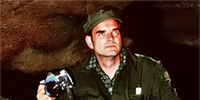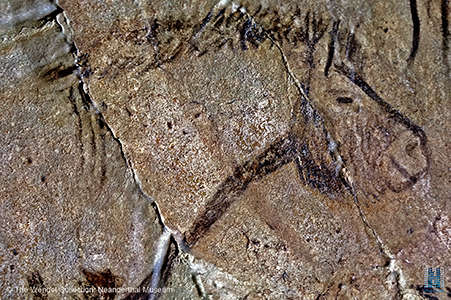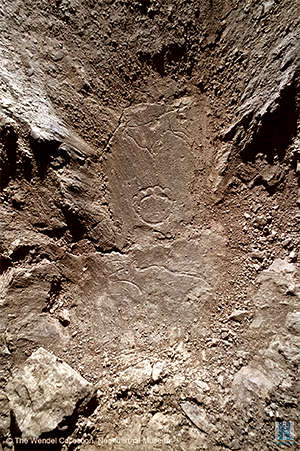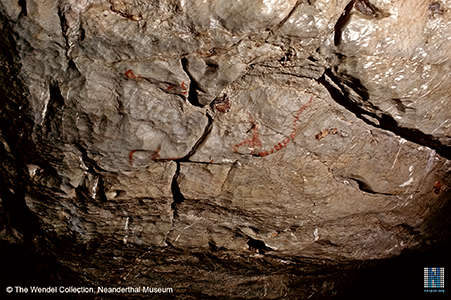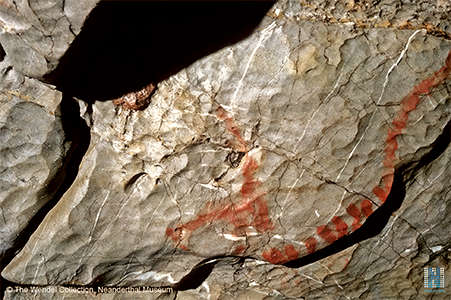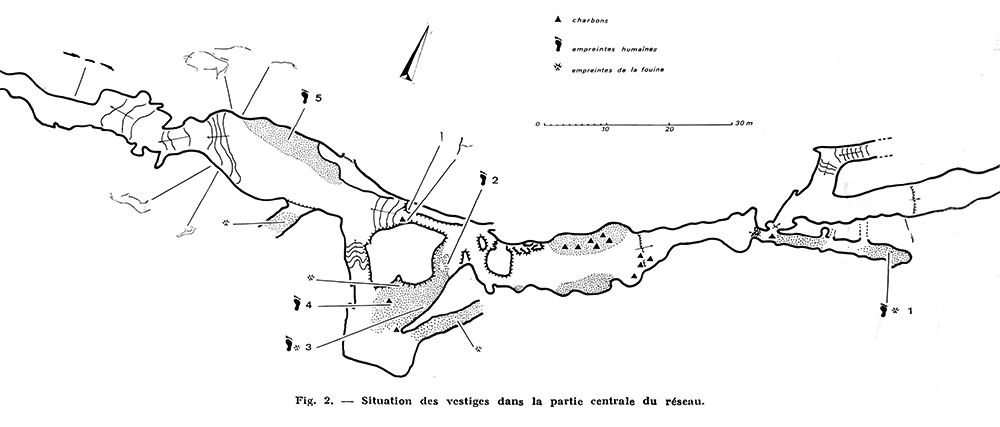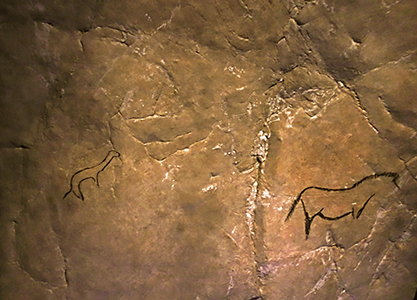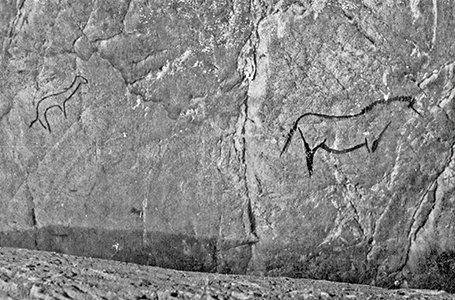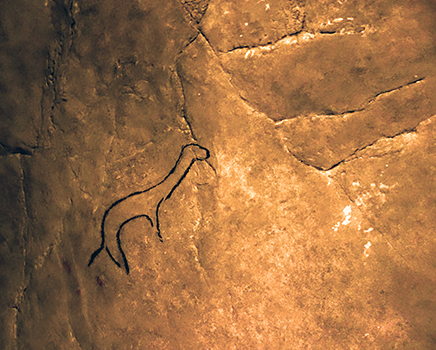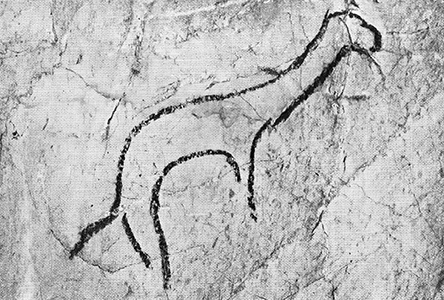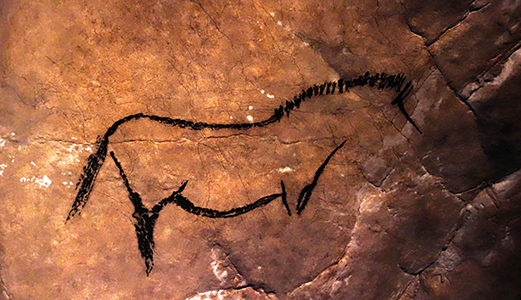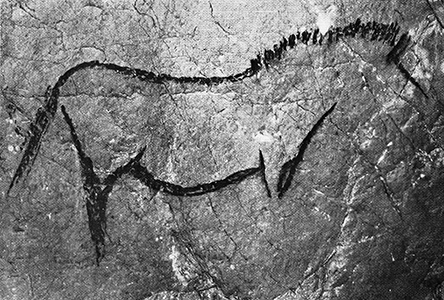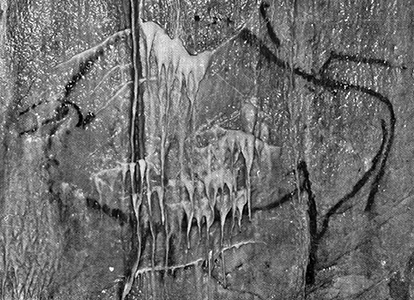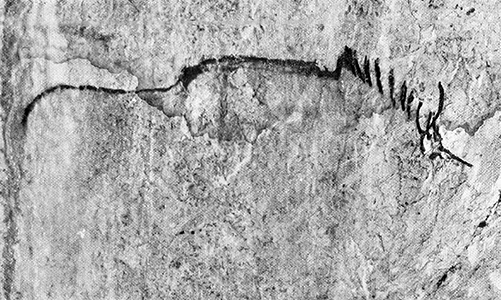Back to Don's Maps
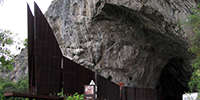
Niaux - Description and History
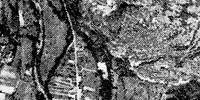
Niaux aerial photo, map and plan
Niaux - Grotte de Niaux Cave Art
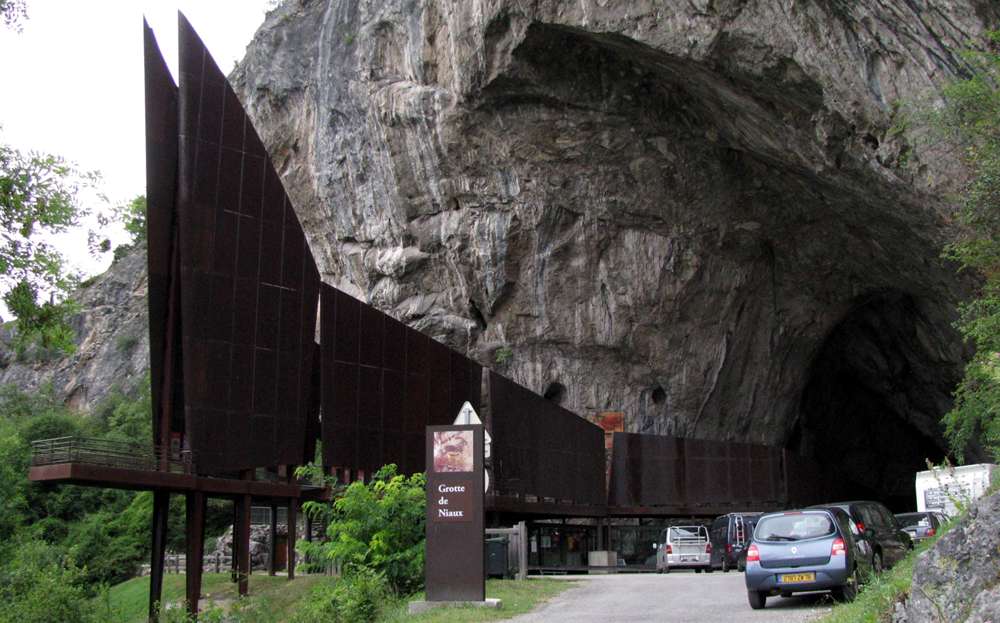
The entrance to Niaux Cave has been wonderfully done. The steel sculpture reflects, in the positive, the negative space of the entrance to the cave. It is a superb work of art, worthy of such an important site. It was designed by Italian architect, Massimiliano Fuksas.
Photo: Don Hitchcock 2008
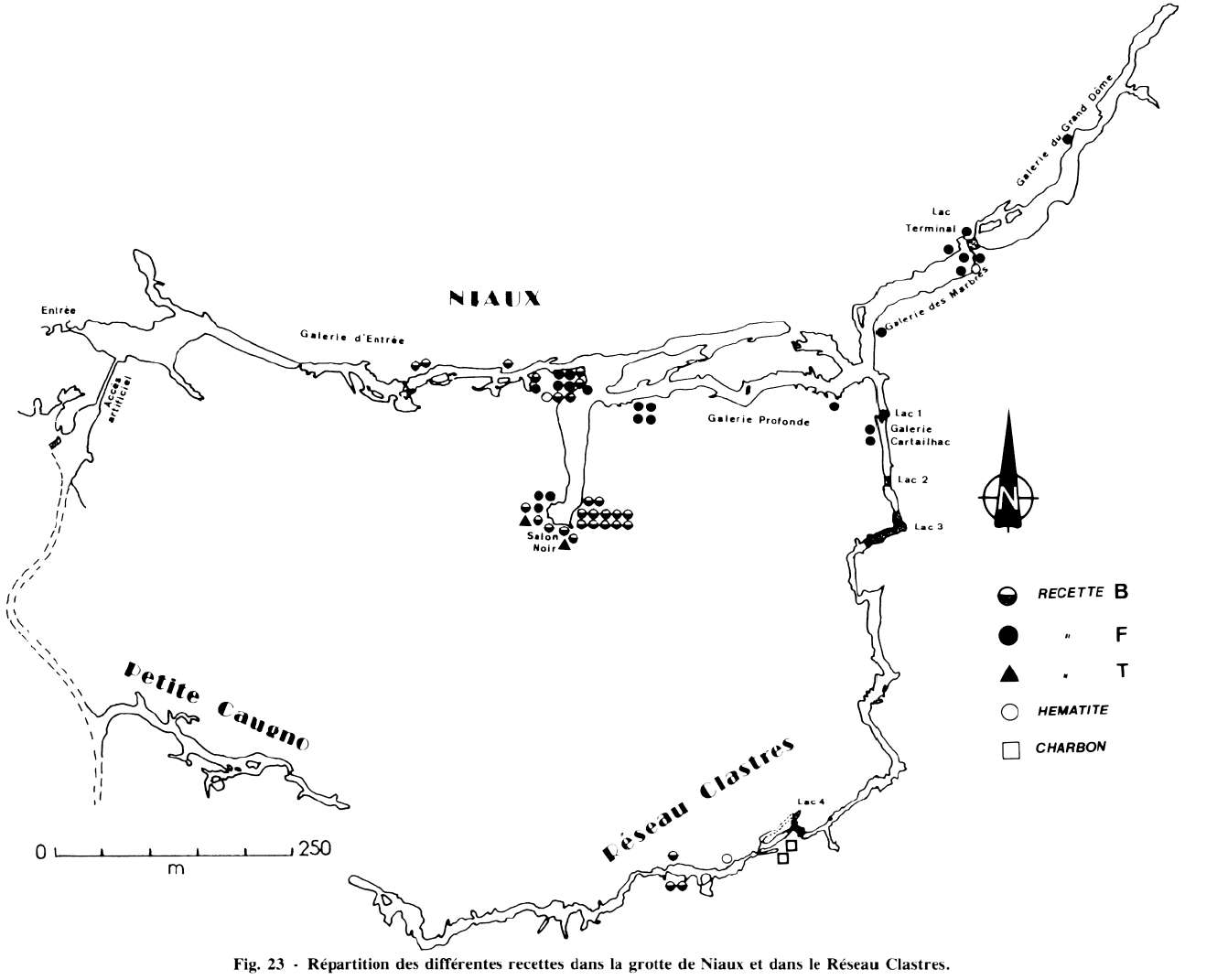
Photo: Clottes, J. et al (1990)
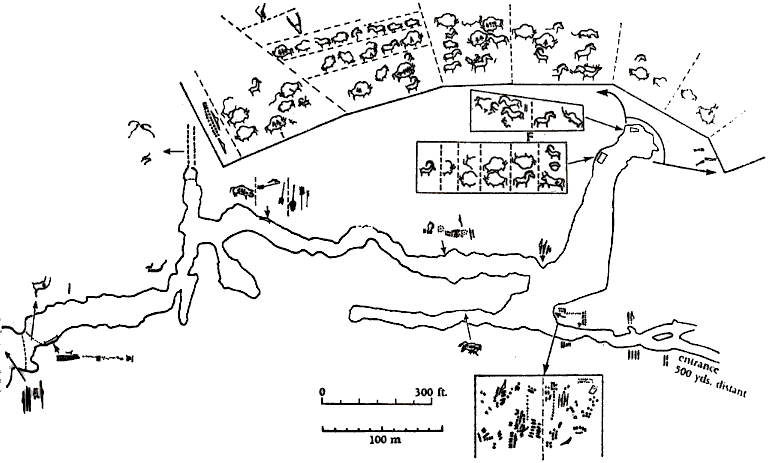
Note that the map has been drawn with north to the bottom of the image!
Divisions within the cave
The following divisions can be made in the cave:
I. The Access Gallery. Without recorded paintings throughout about 500 metres.
II Continuation of the gallery with four groups of red signs in the space of 100 metres, from the "underpass" to the "great crossroads" by the "gallery of the tunnels".
III The Great Crossroads, of about fifty metres in diameter. To this three galleries are opened that are described next:
IV "Runner of the loosenings", or section with rockfalls, with engraving number 124.
V. A Gallery that goes to the "Black Hall", or "Salon Noir" more than 25 m wide, with great "mountains of sand", engravings in the ground and a large painting set in the roundhouse/rotunda.
VI A Deep gallery, that begins with a painted bison and has numerous paintings and engravings, isolated from the others, and ends at the "kettle hole", produced by a collapse, and a new crossroads.
VII. From north to south, the Cartailhac Gallery, with the "Green lake" closing it and black paintings and a red one past this one. It is continued by the Reseau René Clastres.
VIII. Continuation of the deep gallery by the sector of "beautiful marbles", very eroded and with vibrant colors, but without rock art.
IX The "Final Lake", with diverse paintings in red and black on the ceiling, and past this one, the great gallery, as soon as explored, with powerful rockfalls of blocks of great size and an enormous natural cupola of more than 300 m high. There are known, amongst other paintings, two red/black horses, signs and some points. The bottom, obstructed by rockfalls, leads towards the cave of Lombrives. In all the cave there are modern graffiti, some carefully erased by Mr. Clastres; they are from the 19th century, among them is one of the well-known naturalist Nereo Boubée.
X. "René Clastres Network".
As far as findings are concerned, we only can allude to those made in the first sector of the gallery, invaded slightly by water and covered by a heavy layer of white limestone; a dig in which R. Simonnet has worked lately has given ceramics at least of the Bronze Age.
At 400 metres from the entrance, at a point below a rock, some fragments of ceramics have been discovered, very dispersed. At 611 metres, a line of concretion, white, which marks old water levels of up to two metres. It is very probable that the neolithic people never crossed this zone of quite deep water. The red signs begin here. In the Black Hall it seems that Molard discovered some rare units of quartz, some fragments of bone, disturbed, and a piece of a Magdalenien needle, until now the only found palaeolithic piece in Niaux.
Niaux Paintings and Engravings, organised by Gallery
Entry Gallery
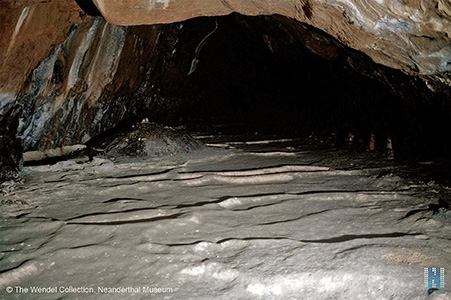
Entry Gallery
The ridges on the floor look like the remains of the calcite edges of gour pools, worn down by many thousands of shod feet during the course of a hundred years or more.
Photo: Heinrich Wendel (© The Wendel Collection, Neanderthal Museum)
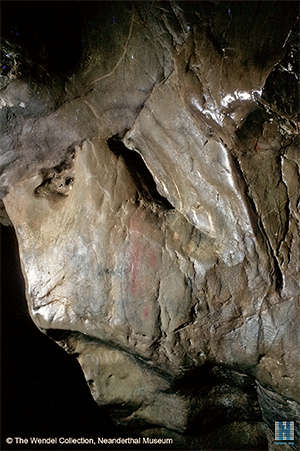
Entry Gallery
Signs on the walls. They are badly smudged, possibly from the effect of many hands touching them.
Photo: Heinrich Wendel (© The Wendel Collection, Neanderthal Museum)
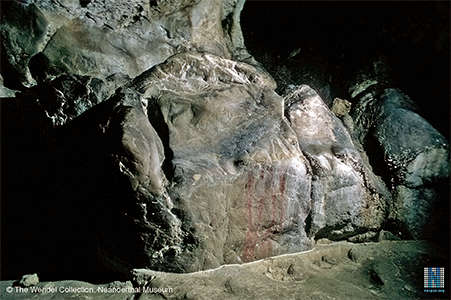
Entry Gallery
These four red almost identical signs are very interesting. It is unusual to have symbols which appear so elongated.
They may originally have been claviform signs. See below.
Photo: Heinrich Wendel (© The Wendel Collection, Neanderthal Museum)
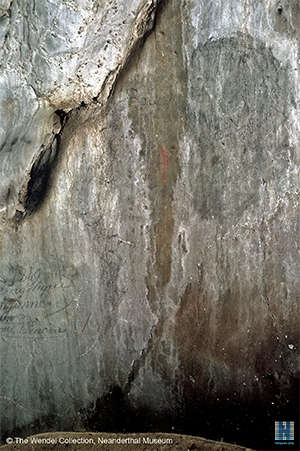
Entry Gallery
This red sign is of the type known as claviform, or club shaped. It is a very common sign, which has not yet been assigned a meaning.
Rappenglück (2002) writes:
In general they consist of a line with an attached half circle, a triangular form or a loop. The protruding part can face to the left or to the right side. In most cases it is situated at the upper part of the line, but it also can be placed in the middle of the stroke. The line itself in the lower part is often bent slightly to the left or to the right side. Thus the claviform reminds one of the letter 'P' of the Latin or Cyrillic alphabet (or the inversed form). It therefore could be simply called the 'P' sign.
The claviforms are painted in red (ochre), seldom in black colour, and sometimes they are engraved too. Claviforms are to be found frequently in a limited region in today's Spain and France, reaching from Cantabrian Spain across the Pyrennean area to the Dordogne and Ardèche valleys.
They mostly belong to the Magdalenian epoch (17 000 - 12 000 BP), except for one example coming from the cave of Chauvet, France, which is much older. With respect to the 14C dating, the claviform can be placed between 22 800 ± 400 BP (Ly-6879) and 32 900 ± 490 BP (Gifa 99776).
The discovery of the P-sign in the Chauvet cave clearly proves that the P-Sign belongs to a very old tradition.
Photo: Heinrich Wendel (© The Wendel Collection, Neanderthal Museum)
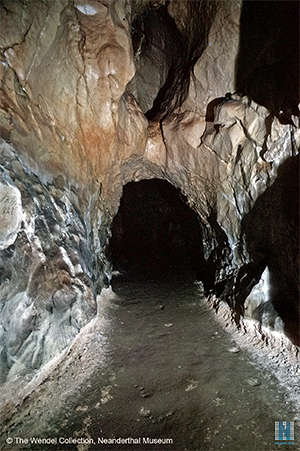
Entry Gallery
The gallery narrows at this point, and it may have been artificially increased in width and height to allow visitors to pass easily.
Photo: Heinrich Wendel (© The Wendel Collection, Neanderthal Museum)
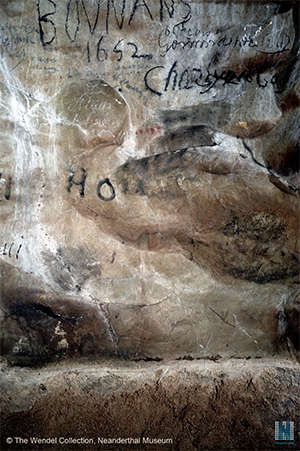
Entry Gallery
Five red dots may be seen on the wall, with, sadly, many graffiti. One purports to be from 1652.
Photo: Heinrich Wendel (© The Wendel Collection, Neanderthal Museum)

Entry Gallery
Here there is at least one red claviform, as well as many dots and short, mostly horizontal, lines in red and black.
This image also demonstrates by means of the rough concretions close to the floor that the area was once inundated for a long period of time.
Photo: Heinrich Wendel (© The Wendel Collection, Neanderthal Museum)
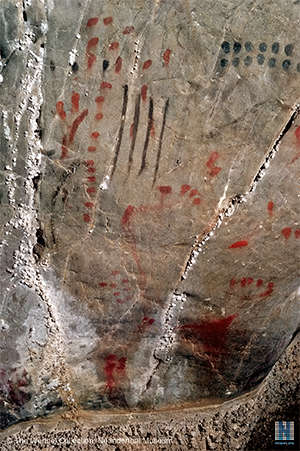
Entry Gallery
Four long black vertical lines, as well as many black and red dots, some arranged in rows and columns.
Photo: Heinrich Wendel (© The Wendel Collection, Neanderthal Museum)
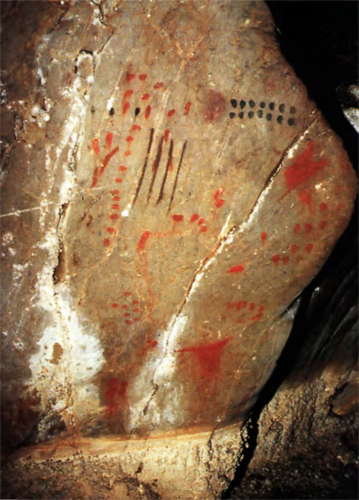
Signs, Niaux.
Photo: Jean Clottes
Source: http://futurehistory.aiga.org/resources/content/2/2/6/8/documents/n_mayer.pdf
Salon Noir
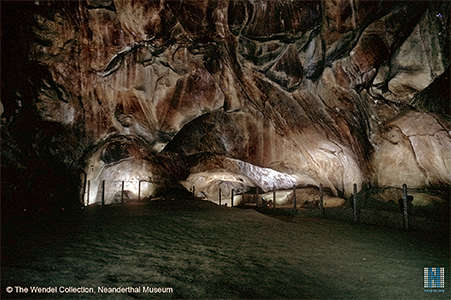
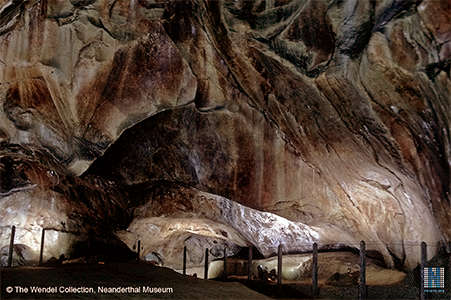
Salon Noir
These are amazing photographs, only obtainable with special permission and the cooperation of many authorities. Herr Wendel has five or six assistants with 'slave flashes' lying on the floor in front of the walls of the cave. The slave flashes are driven by the flash on his camera, and all fire together to create this wonderful effect.
The trick would be to get all the flashes pointing the correct way, though this is achievable with what has now become normal, low powered modelling lights forming part of each slave flash unit.
Since he was working with slide film, rather than a digital camera, however, pulling off a feat like this with such success is very difficult, since there can be no feed back as to how the exposure went. Seeing these superb images when they came back from the lab must have been a big relief.
Photo: Heinrich Wendel (© The Wendel Collection, Neanderthal Museum)
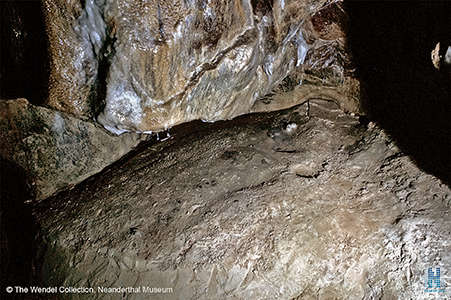
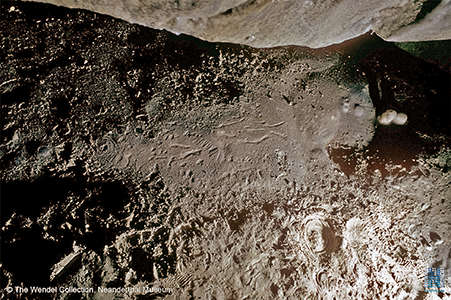
Salon Noir
At the approach to the Salon Noir can be found this engraving of a a trout or salmon in the sandy clay of the floor of a small side passage.
Photo: Heinrich Wendel (© The Wendel Collection, Neanderthal Museum)

Salon Noir
In a few strokes, the artist has delineated the essentials of the fish.
The light is coming from the 'south east' which means that many people will see this as a projection from the floor rather than an engraving. If one concentrates on seeing the shadows as being in front of the lighter areas, and representing grooves in the floor, and being cast by the flat floor, it is easier to see the engraving correctly.
Photo: Heinrich Wendel (© The Wendel Collection, Neanderthal Museum)
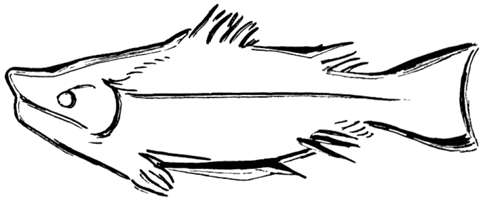
This is a line drawing of the fish, a a trout or salmon, engraved in the compacted sandy clay of a side passage, at the entrance to the Salon Noir.
Photo: Breuil, Cartailhac (1907)
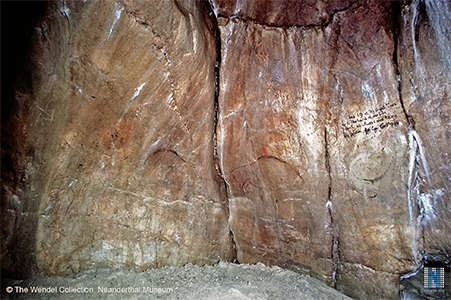
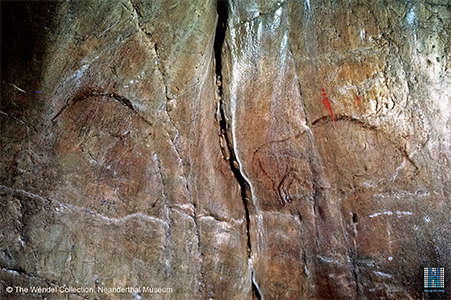
Salon Noir
Alcove of Bison. Note also the P shaped red claviform figure above the right hand bison most clearly seen in the right most photograph.
Photo: Heinrich Wendel (© The Wendel Collection, Neanderthal Museum)
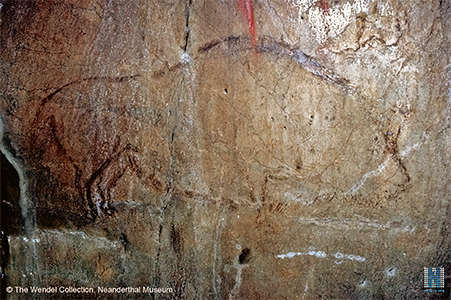
Salon Noir
Right hand bison in the alcove above.
Photo: Heinrich Wendel (© The Wendel Collection, Neanderthal Museum)
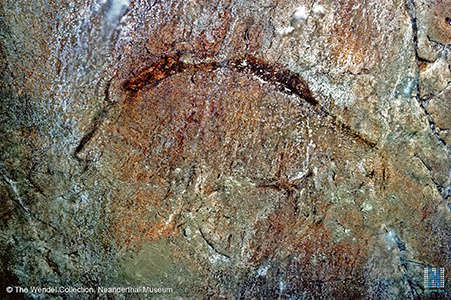
Salon Noir
Left most bison in the alcove.
Photo: Heinrich Wendel (© The Wendel Collection, Neanderthal Museum)
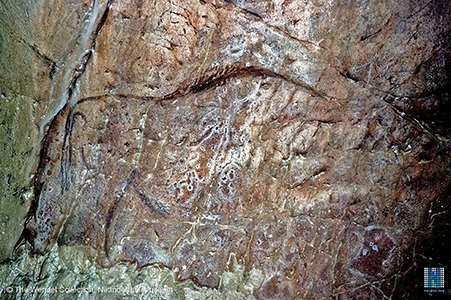
Salon Noir
Tail, back right leg, part of the abdomen, and the dorsal line from the tail as far as the bristled hump, of a bison.
Photo: Heinrich Wendel (© The Wendel Collection, Neanderthal Museum)
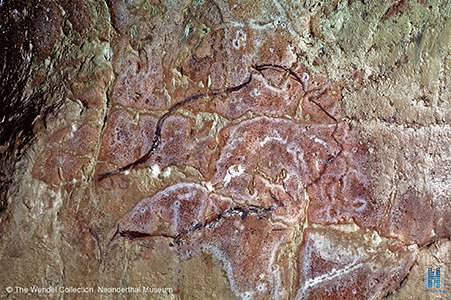
Salon Noir
Almost complete outline of a bison, with much enlarged head and forequarters compared with the small rump and back leg.
Photo: Heinrich Wendel (© The Wendel Collection, Neanderthal Museum)
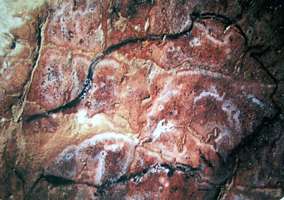
The stylised bison from the Salon Noir, shown also above, has been given a radiocarbon date of 13 850 ±150 BP
Photo and text: Public display outside Niaux Cave

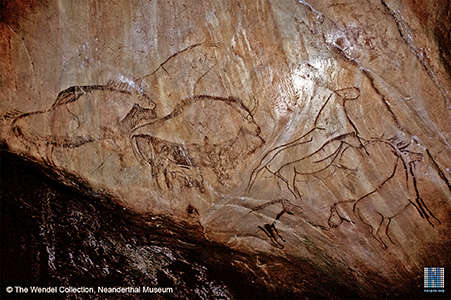
Salon Noir
A complex panel which includes two Bison with large beards and dewlaps, the outline of what is probably a horse, a detailed horse somewhat obscured below that, a well executed horse head facing to the left, and a beautifully outlined stag.
Photo: Heinrich Wendel (© The Wendel Collection, Neanderthal Museum)

Stag panel, Niaux. Panel IV, deer, feline, horses, bisons.
Photo: J. Vertut
Source and text:Leroi-Gourhan (1984)

Part of the panel above, with horses and a stag, painted in black outline. The stag measures 100 cm from antler tip to hind hoof.
Photo and text: Sieveking (1979)
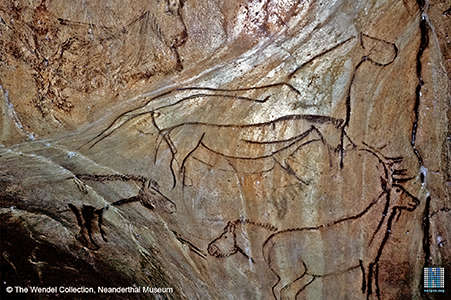
Salon Noir
This image shows the three horses and the stag.
The uppermost horse has a second horse drawn inexpertly on top of it, making four altogether in this image.
Photo: Heinrich Wendel (© The Wendel Collection, Neanderthal Museum)

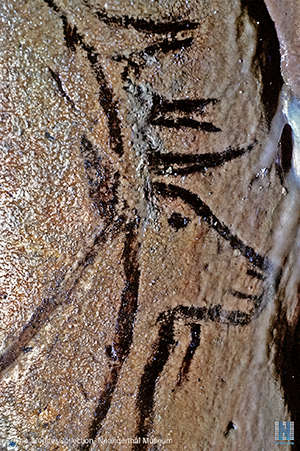
Salon Noir
The stag has been superbly drawn.
Photo: Heinrich Wendel (© The Wendel Collection, Neanderthal Museum)
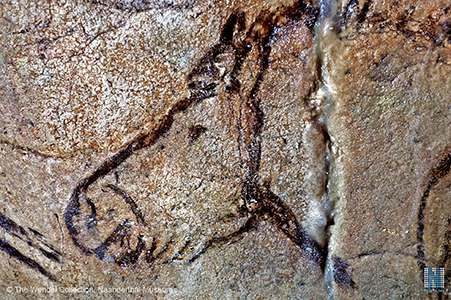
Salon Noir
A well drawn horse head.
Although there has been a deposit of calcite on the wall since these images were drawn, it has served more to preserve the art than to obscure it.
Photo: Heinrich Wendel (© The Wendel Collection, Neanderthal Museum)
Salon Noir
Horse showing the stiff mane and beard of the horses of the time, only the fore part of the horse is shown.
The head is particularly well sketched, and I suspect the same artist did this image and the one of the left facing head above. The techniques are very similar.
Photo: Heinrich Wendel (© The Wendel Collection, Neanderthal Museum)
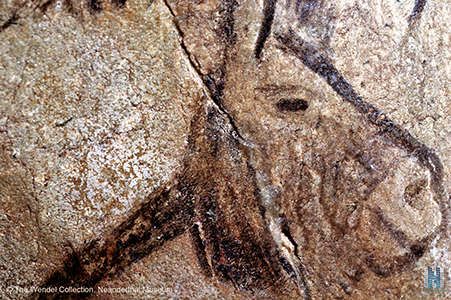
Salon Noir
Close up of the head of the horse above.
Photo: Heinrich Wendel (© The Wendel Collection, Neanderthal Museum)
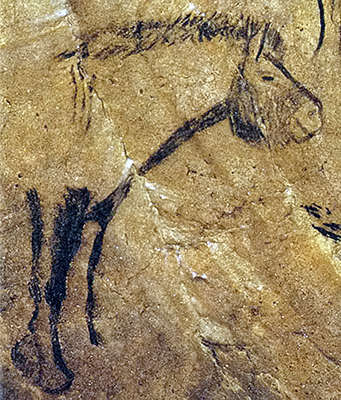
Caverne de Niaux (Ariège)
Salon Noir, Cheval barbu
Black room, bearded horse
Photo from: Agenda de la Préhistoire 2002 - 2003, a superb diary with excellent illustrations sent to me by Anya. My thanks as always.

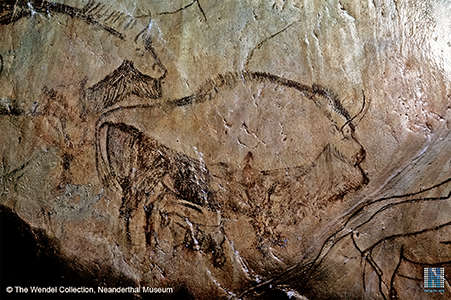
Salon Noir
The two bison in the complex panel referred to above.
In photo on the right we can see clearly an ibex drawn below the right hand bison.
Photo: Heinrich Wendel (© The Wendel Collection, Neanderthal Museum)
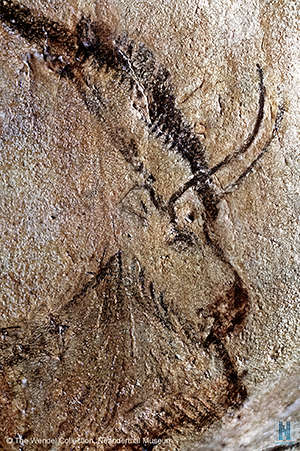
Salon Noir
Head of the right hand bison.
Photo: Heinrich Wendel (© The Wendel Collection, Neanderthal Museum)
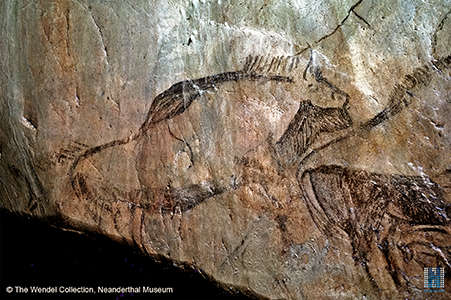
Salon Noir
Left hand bison.
It should be noted that both bison have been drawn with quite dark ventral regions, either denoting hair, or a colour variation like the black saddles sometimes seen on paintings of Rhinoceroses, for example at Chauvet.
Photo: Heinrich Wendel (© The Wendel Collection, Neanderthal Museum)
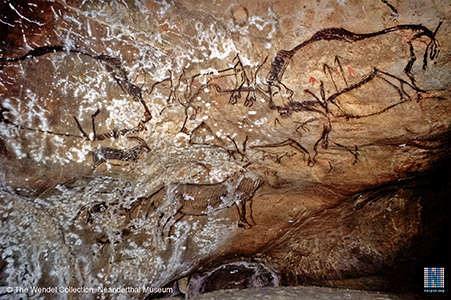
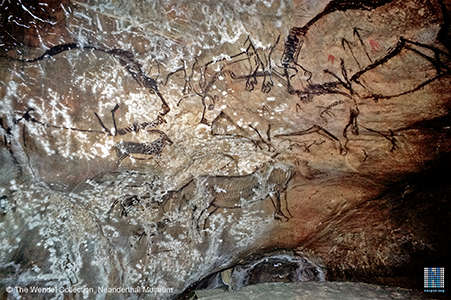
Salon Noir
Another complex panel. Bison, Horses, and a superb Ibex.
Photo: Heinrich Wendel (© The Wendel Collection, Neanderthal Museum)
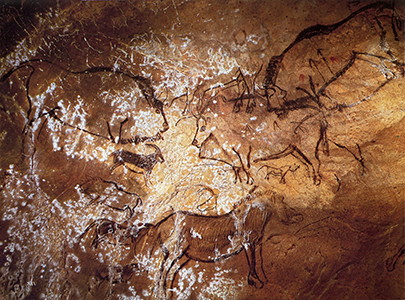
Another view of Panel 3 above.
Photo: J. Vertut
Source: Leroi-Gourhan (1984)

Salon Noir
This Bison always perplexes me. Is that arc an eye, or an eyebrow missing an eye?
In any case, there are what appear to be (to modern eyes) black arrows on the body, indicating - what? Places to shoot for when hunting? Something else entirely, some esoteric symbol, not now decipherable as to meaning?
Then there are two red arrows, most likely added later, which complicate matters.
In addition, there is what might be interpreted as a human ear, as well as clearly indicated mane and beard/dewlap. The tail has a very strong and thick support from the hindquarters.
Photo: Heinrich Wendel (© The Wendel Collection, Neanderthal Museum)
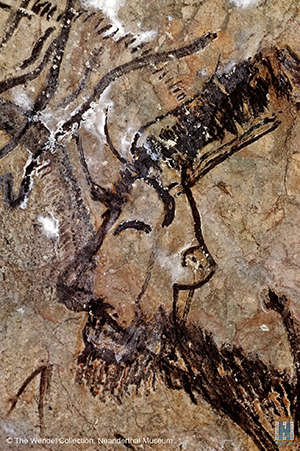
Salon Noir
In this closeup of the Bison above, it is possible to see a human face replacing the typical bovine face. Notice the nose, the ear, the eyebrow, the lips, the chin - even the beard is that of a human male!
I can't help but think that it might be a caricature of the face of a human male known to the artist, put onto a bison body as a joke.
Photo: Heinrich Wendel (© The Wendel Collection, Neanderthal Museum)
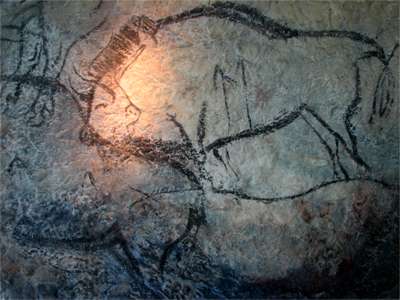
Bison from the salon noir, a facsimile from the Brno Museum Anthropos.
Photo: HTO
Permission: Public domain
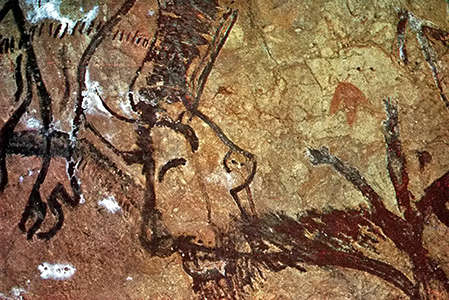
Bison.
Photo: Beltrán Martínez (1973)
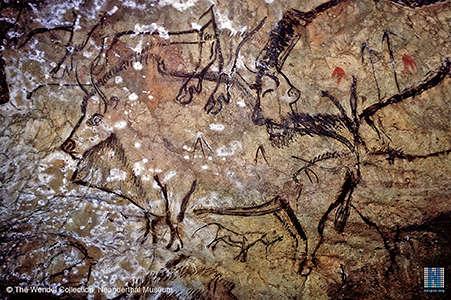
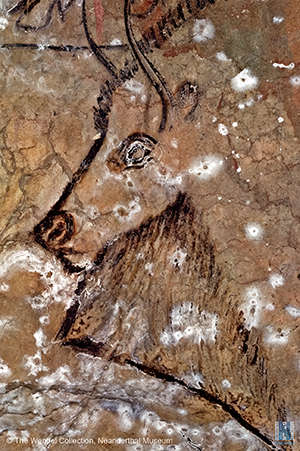
Salon Noir
This is altogether a much 'prettier' vision of a Bison. It is delineated with great care, with various widths of line as appropriate. The muzzle is in proportion to reality, the mouth and nose are in the correct place, and the beard/dewlap is finely drawn. The horns are done with precision and an elegant arc, the eye is large and expressive.
Altogether a superb piece of art.
Photo: Heinrich Wendel (© The Wendel Collection, Neanderthal Museum)
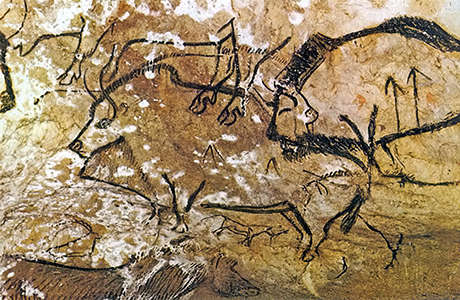
Caverne de Niaux (Ariège)
Successive paintings, one on top of the other
Photo: Waechter (1991)
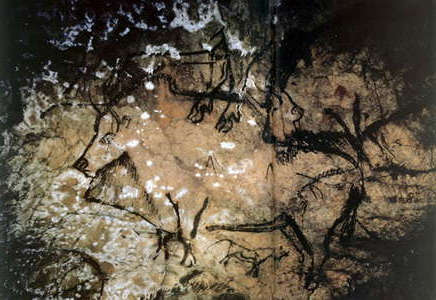
Bison, Niaux.
This image has been horizontally reversed to accord with reality.
Photo: http://www.istmira.com/foto-i-video-pervobytnoe-obschestvo/3923-iskusstvo-predystorii-pervobytnost-1.html

Bison, as in the image above.
This large cavern maintains a relatively level horizontal plane, though with height differences that can be noticeable. It is, altogether, more than 1400 m long and an exhaustive exploration of the end of the gallery beyond the last lake has not been made.
Photo and text: Beltrán Martínez (1973)
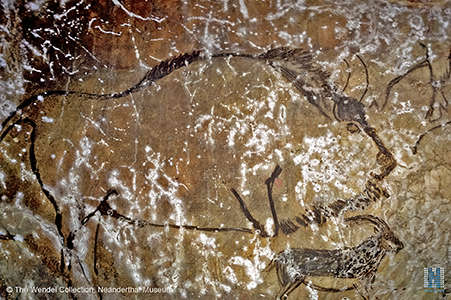
Salon Noir
This Bison has been drawn to convey a sense of huge mass and even menace. The legs are just stumps, as seems to be a common convention in the depictions of Bison in Niaux.
Photo: Heinrich Wendel (© The Wendel Collection, Neanderthal Museum)
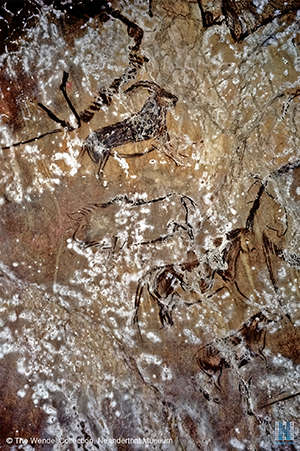
Salon Noir
A minor menagerie of a superbly drawn Ibex, a quick sketch of a Bison, and two images of Horses, both apparently with colour patterns like modern Pintos on their hides.
Photo: Heinrich Wendel (© The Wendel Collection, Neanderthal Museum)


Salon Noir
This Ibex is one of the most beautifully realised of all the animals on the walls of Niaux.
The proportions are perfect, and the beautifully patterned coat, the well drawn head and ears, and the superb horns are a joy to the eye.
Photo: Heinrich Wendel (© The Wendel Collection, Neanderthal Museum)
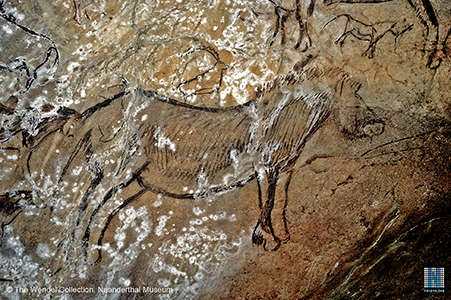
Salon Noir
This large Horse to the right and lower than the Ibex shows well the erect mane, the plentiful hair on the rest of the body, the line of the back and the swell of the abdomen of this animal of the plains.
It should be realised that Ibex were one of the few species of hunted animals in the Vicdessos valley in which Niaux sits, and the reason for the presence of the artists.
The Horse and Bison are animals of the plains, and were hunted by the artists in the summer when they left the valley, where they lived in the Grotte de la Vache just across the Vicdessos valley, a few hundred metres from Niaux, in winter, and went to the plains for the summer to hunt, returning to Grotte de la Vache (and Niaux) at the start of the next winter.
They did not live in Niaux, it was used only as an art studio and gallery. Grotte de la Vache is smaller, though with more than adequate space for a hunting band, with a much lower ceiling, well lit, dry, and close to the large, wide valley floor where the ibex congregated, eating the grass not available on the peaks in winter.
Photo: Heinrich Wendel (© The Wendel Collection, Neanderthal Museum)
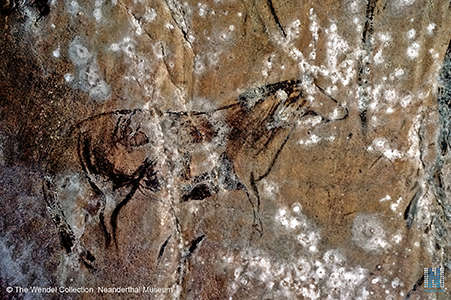
Salon Noir
The lower of the two small horses in this group is shown here, apparently with a pattern on its body, like the one above it.
Photo: Heinrich Wendel (© The Wendel Collection, Neanderthal Museum)

Salon Noir
A Bison apparently drawn longer in comparison to height/thickness of the body than real life on the right, with four or five 'arrowheads' drawn on it, perhaps with ritual significance. On the left, a realistic drawing of another Bison, with mane, beard/dewlap and lower body hair shown clearly.
It is probable, however, that the rock panel on which the 'elongated' Bison is drawn is sloping back from the viewer, giving a distorted view.
Photo: Heinrich Wendel (© The Wendel Collection, Neanderthal Museum)

Salon Noir
From this closeup viewpoint, the right hand Bison is of correct proportions.
Below the right hand Bison is a well drawn outline of an Ibex, and above it the head of another Ibex.
Photo: Heinrich Wendel (© The Wendel Collection, Neanderthal Museum)
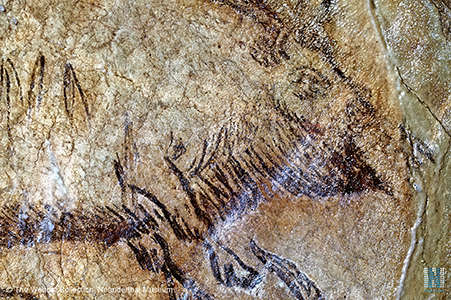
Salon Noir
Head of the Bison on the right.
Photo: Heinrich Wendel (© The Wendel Collection, Neanderthal Museum)
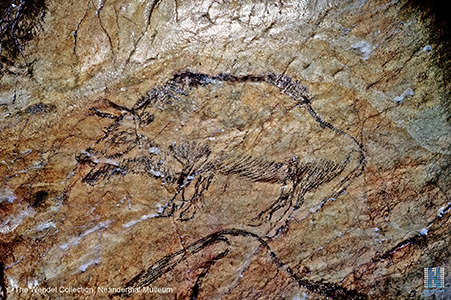
Salon Noir
The left hand Bison from the pair. Note that it appears to have been taken at an angle to the rock surface, leading to distortion, especially noticeable in the muzzle and the angles of the legs.
Notice also the film of calcite over the painting, which both obscures and enhances the drawing by the well known wetting* effect, as well as protecting it under an almost transparent layer.
* for example, wetting an abraded gemstone will temporarily increase its colour and intensity. Gem fossickers often lick a river pebble to see if it has any 'colour', and otherwise worthless chips of opal are often sold cheaply in glass cylinders filled with water or glycerine, or immersed in, or painted with, epoxy resin.
Photo: Heinrich Wendel (© The Wendel Collection, Neanderthal Museum)
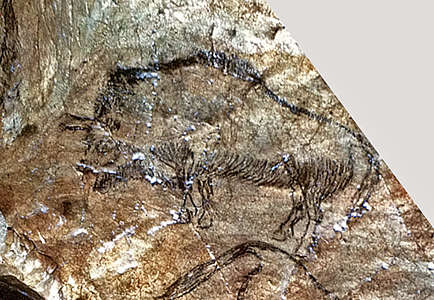
Salon Noir
For comparison, this is the image from the distant shot of the Bison above, which removes much of the distortion apparent in the photo above.
Photo: Heinrich Wendel (© The Wendel Collection, Neanderthal Museum)
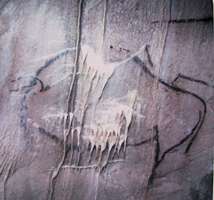
Some of the images have been covered in calcite. This can preserve the paintings if it is thin, but it can also obscure the art, as is happening here.
Photo: Public display outside Niaux Cave
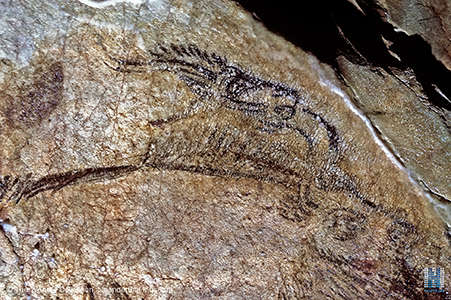
Salon Noir
Head of Ibex above the Bison head.
Photo: Heinrich Wendel (© The Wendel Collection, Neanderthal Museum)
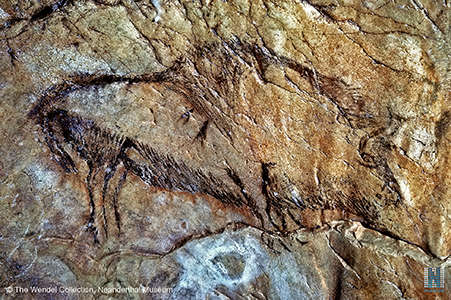
Salon Noir
Bison.
Photo: Heinrich Wendel (© The Wendel Collection, Neanderthal Museum)
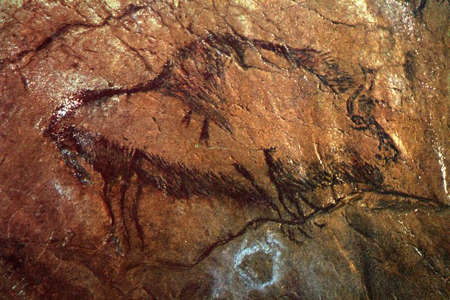
Bison.
Photo: Beltrán Martínez (1973)
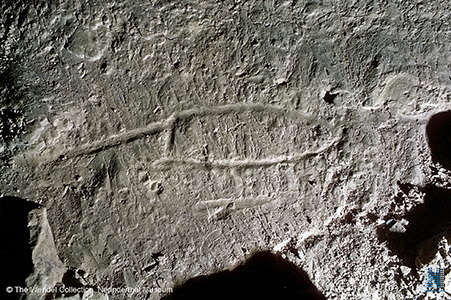
Salon Noir
Engraving. I have been unable to determine what this might represent.
La Grotte de Niaux has large amounts of sand on the floor in some places, left by the waters, and in places has been hardened by limestone deposition.
Photo: Heinrich Wendel (© The Wendel Collection, Neanderthal Museum)
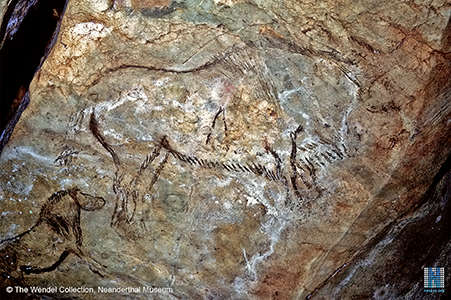
Salon Noir
Bison. The surface inside the outline of the head seems to have worn off or flaked away.
Photo: Heinrich Wendel (© The Wendel Collection, Neanderthal Museum)
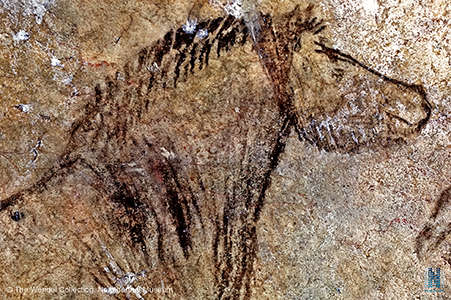
Salon Noir
Head of a beautifully sketched Horse, shown also in the image above.
Photo: Heinrich Wendel (© The Wendel Collection, Neanderthal Museum)
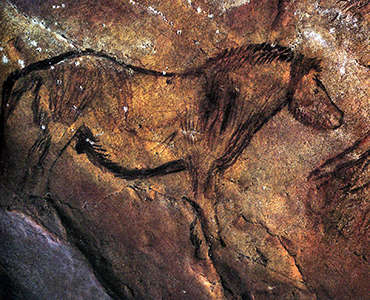
Horse with coat markings shown by hatched shading. Salon Noir, Niaux, Ariège. Length 30 cm
Photo: Sieveking (1979)
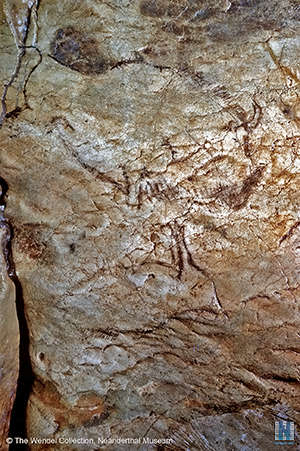
Salon Noir
Two Bison, one of which has been drawn upside down.
Photo: Heinrich Wendel (© The Wendel Collection, Neanderthal Museum)
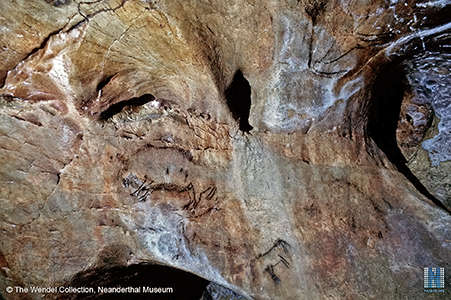
Salon Noir
Bison and two partial horses, with possibly the remains of a bison on the right.
Photo: Heinrich Wendel (© The Wendel Collection, Neanderthal Museum)
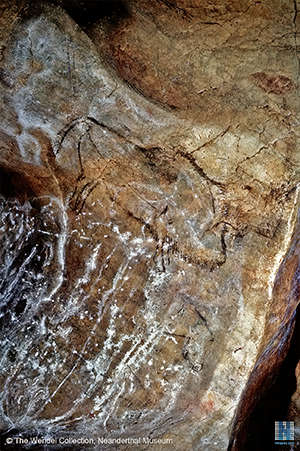
Salon Noir
Bison.
Photo: Heinrich Wendel (© The Wendel Collection, Neanderthal Museum)
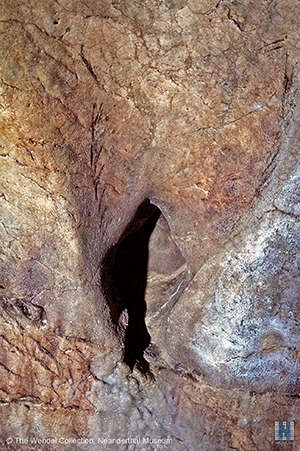
Salon Noir
The artist has drawn just the antlers of a deer around this hole in the wall, with the hole suggesting the head of the deer.
Photo: Heinrich Wendel (© The Wendel Collection, Neanderthal Museum)
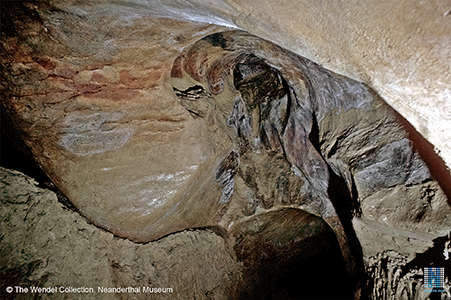
Salon Noir
The indistinct red ochre markings in the top left of this image are difficult to interpret.
Photo: Heinrich Wendel (© The Wendel Collection, Neanderthal Museum)
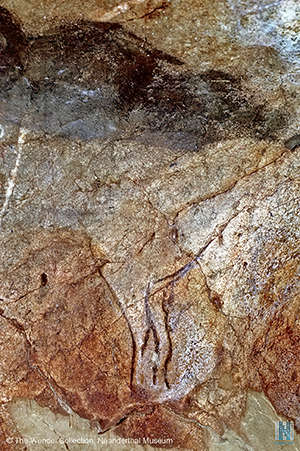
Salon Noir
All that remains of this painting are the legs of the animal, possibly a deer.
Photo: Heinrich Wendel (© The Wendel Collection, Neanderthal Museum)
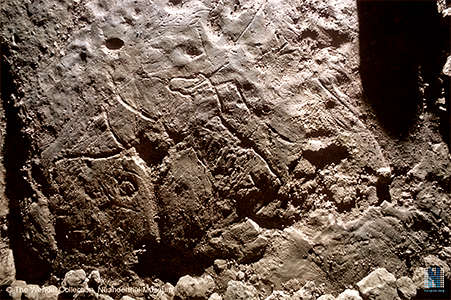
Salon Noir
This engraving is difficult to decipher, but there is certainly a horse in the centre of the image, going up at an angle of 45° from this viewpoint, with the head of a bison to its left.
Photo: Heinrich Wendel (© The Wendel Collection, Neanderthal Museum)
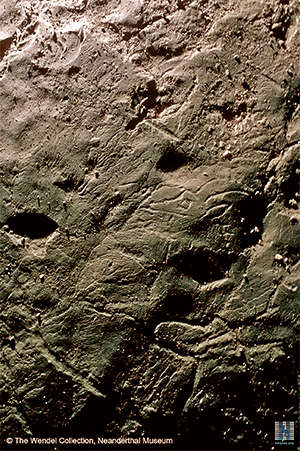
Salon Noir
Above the horse is the head of an ibex carved into the sandy clay.
Photo: Heinrich Wendel (© The Wendel Collection, Neanderthal Museum)
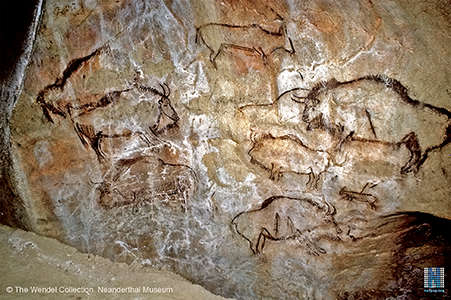
Salon Noir
This large panel incorporates more than six Bison, a Deer, and what may be an Ibex.
Photo: Heinrich Wendel (© The Wendel Collection, Neanderthal Museum)
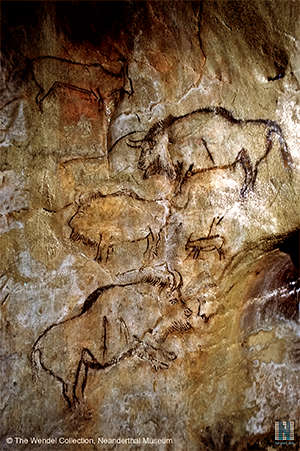
Salon Noir
This part of the panel includes three well drawn bison, the dorsal line of another, an isolated bison head, a deer at the top, and what may be an ibex with spears sticking out from it.
Photo: Heinrich Wendel (© The Wendel Collection, Neanderthal Museum)
 Bison.
Bison.
The first gallery has an approximately east - west direction for about 600 m, then it goes North - South and it ends at the rotunda of the "Black Hall", or "Salon Noir".
Photo: Beltrán Martínez (1973)
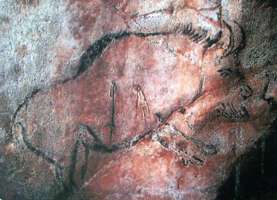
This bison from the Salon Noir has been given a radiocarbon date of 12 890 ±160 BP
Photo and text: Public display outside Niaux Cave
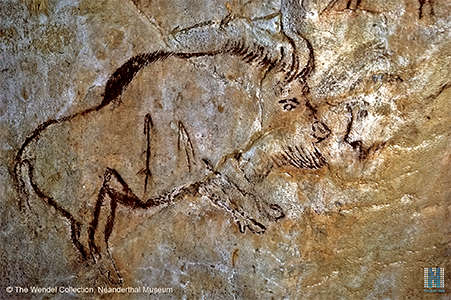
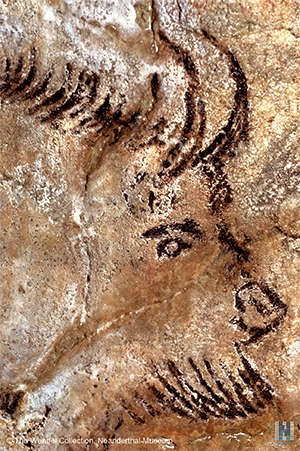
Salon Noir
This well drawn bison from the panel above has an eyebrow and eye drawn clearly, as well as the nose and the beard/dewlap. Two symbols which we would interpret as arrows are drawn on the bison, with an isolated bison head facing it.
Photo: Heinrich Wendel (© The Wendel Collection, Neanderthal Museum)
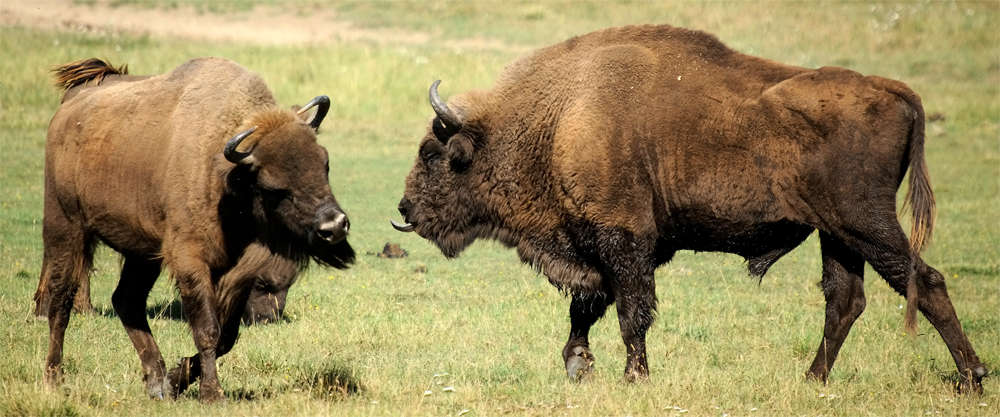
This photograph shows clearly that European Bison did in fact have eyebrows with distinct eyebrow ridges, and also shows well the beard and dewlap of the beasts.
Photo taken in Réserve biologique des Monts d'Azur, Haut-Thorenc, France
Photo: Valène Aure
Date: 22 August 2011
Permission: Creative Commons Attribution-Share Alike 3.0 Unported license
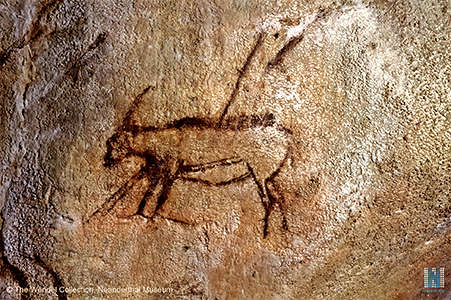
Salon Noir
Ibex with one spear in its back, and two in the neck. The mark across the body is probably the natural division on the flank of the animal, see below. This is either a female or a young ibex, going on the small length of the horns.
Photo: Heinrich Wendel (© The Wendel Collection, Neanderthal Museum)
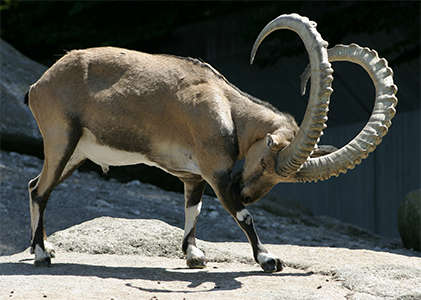
This is a superb photograph of a male Ibex in peak condition, showing the colour variation along the flank. This is presumably for camouflage, they are rock coloured when looked at from above, and light coloured against the sky or snow when looked at from below, with parti-colour on the legs for camouflage.
Photo: Nino Barbieri
Permission: This file is licensed under the Creative Commons Attribution-Share Alike 2.5 Generic license.
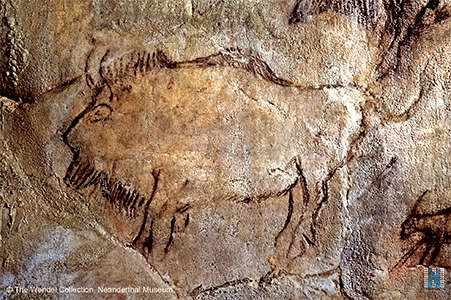
Salon Noir
Bison.
Photo: Heinrich Wendel (© The Wendel Collection, Neanderthal Museum)
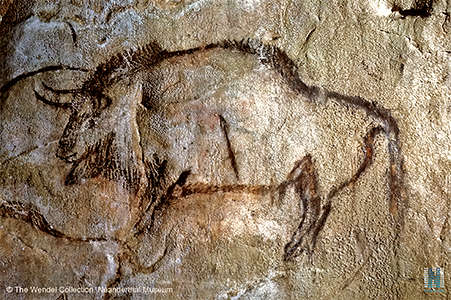

Salon Noir
Bison.
Photo: Heinrich Wendel (© The Wendel Collection, Neanderthal Museum)
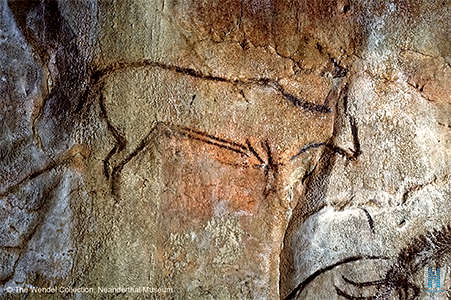
Salon Noir
Deer.
Photo: Heinrich Wendel (© The Wendel Collection, Neanderthal Museum)
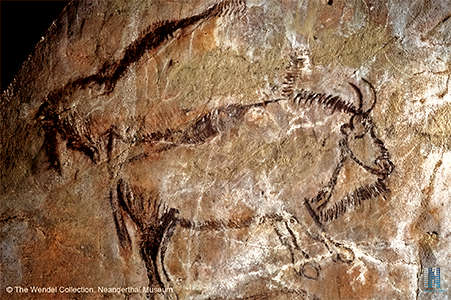
Salon Noir
Bison.
Photo: Heinrich Wendel (© The Wendel Collection, Neanderthal Museum)
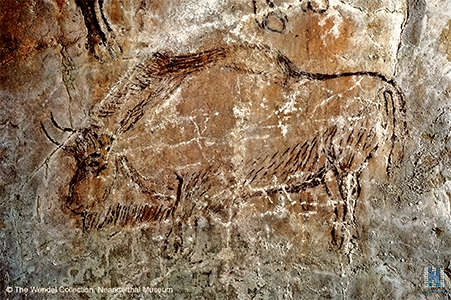
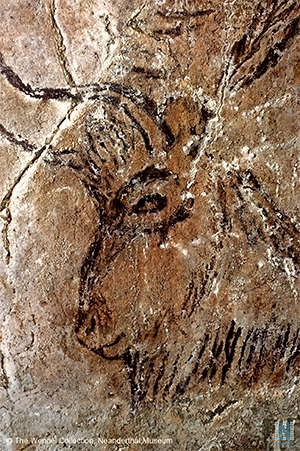
Salon Noir
Bison with a malevolent expression on its face. Hunting these animals, which could weigh up to one ton, would have required great courage under some circumstances.
On the basis of style and artistic ability, I believe the same artist who did the superb ibex above (and below) also completed this figure.
Photo: Heinrich Wendel (© The Wendel Collection, Neanderthal Museum)


Salon Noir
Here is the ibex again for comparison.
Photo: Heinrich Wendel (© The Wendel Collection, Neanderthal Museum)
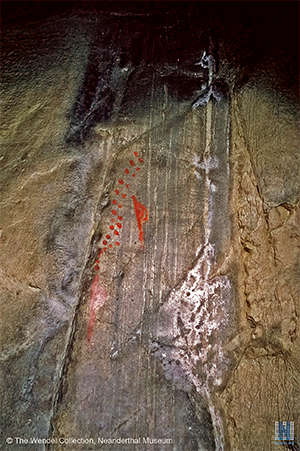
Salon Noir
Two claviform symbols, and a double line of dots. No one knows what the claviform symbols represent, but to me they look like a symbol for a pregnant woman.
Photo: Heinrich Wendel (© The Wendel Collection, Neanderthal Museum)
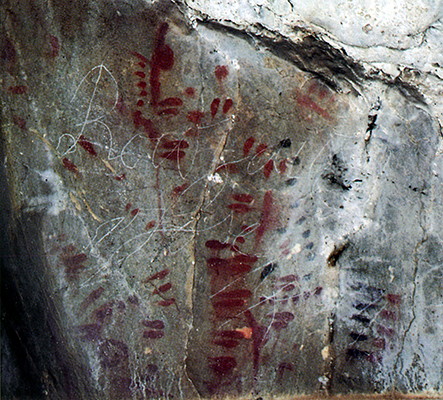
Salon Noir
Large panel of signs.
Photo: J. Clottes
Source and text: Leroi-Gourhan (1984)
Salon Noir
Engravings, from the bottom to the top:
• Aurochs
• Symbol reminiscent of a cave bear paw print - but there were no cave bears there at the time of the Niaux artists
• Ibex, probably female.
The hunters of Grotte de la Vache / Niaux indiscriminately hunted goats of all ages and both sexes without making a selection on the basis of sex or age or size. (Pailhaugue, 1998)
Photo: Heinrich Wendel (© The Wendel Collection, Neanderthal Museum)
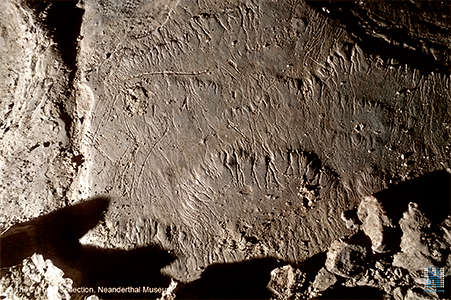
Salon Noir
Engraving showing the outline of a horse.
Photo: Heinrich Wendel (© The Wendel Collection, Neanderthal Museum)
Galerie des Marbres
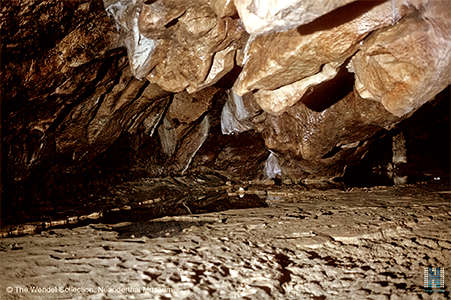
Galerie des Marbres
Entry.
Photo: Heinrich Wendel (© The Wendel Collection, Neanderthal Museum)
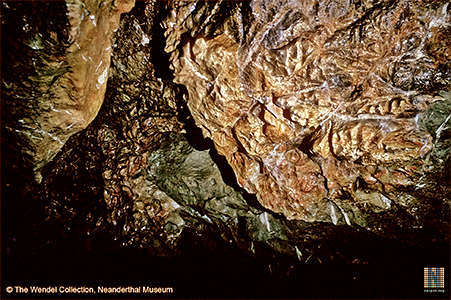
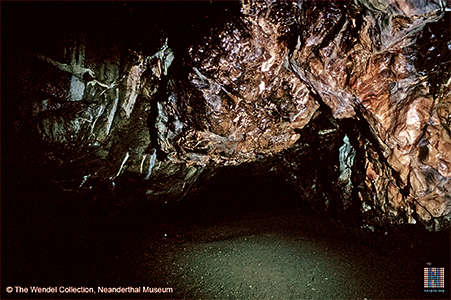
Galerie des Marbres
The walls and ceiling of this gallery are highly complex, shaped by the solution of the limestone by water.
Photo: Heinrich Wendel (© The Wendel Collection, Neanderthal Museum)
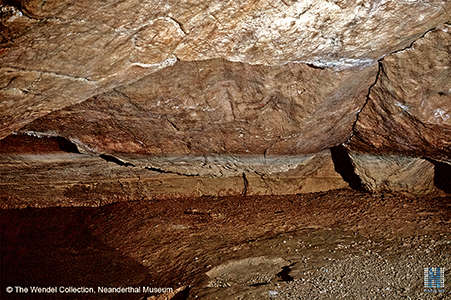
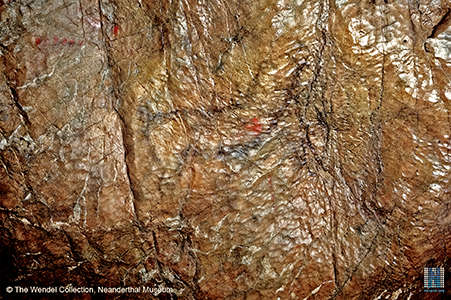
Galerie des Marbres
On this ceiling the long and relatively thin body of an animal has been painted in black, with a red patch near where the heart may be.
The animal is shaped somewhat like a canine, but with a very thick neck.
Photo: Heinrich Wendel (© The Wendel Collection, Neanderthal Museum)
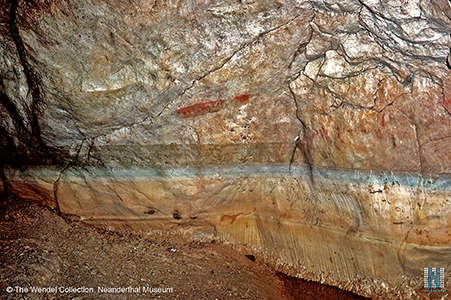
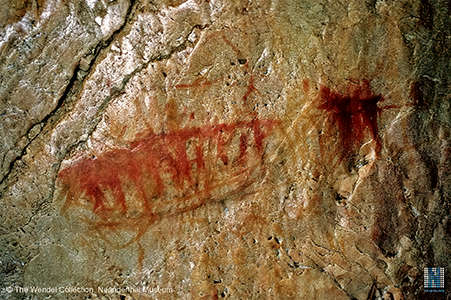
Galerie des Marbres
This symbol is hard to interpret. It almost seems to be a doodle that has been painted over when no longer needed.
The water level in this section of the cave once came perilously close to the artworks, as can be seen in the photo on the left.
To the right of the symbol are a line of red and a line of black dots, as can also be seen in the photo on the left.
Photo: Heinrich Wendel (© The Wendel Collection, Neanderthal Museum)
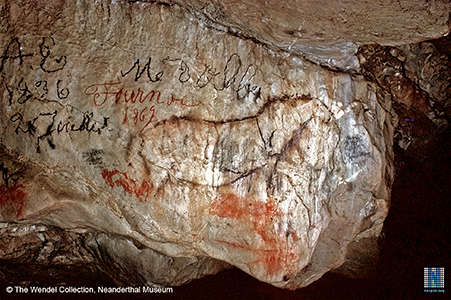
Galerie des Marbres
A horse, with several examples of graffitti.
I cannot help but wonder about the authenticity of this image, especially given its proximity to so much graffitti.
The style is unlike any other in Niaux.
Photo: Heinrich Wendel (© The Wendel Collection, Neanderthal Museum)
Galerie Profonde
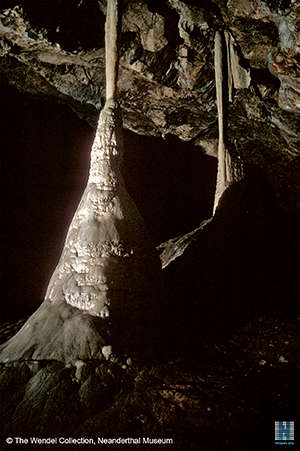
Galerie Profonde
A particularly beautiful cone shaped stalagmite rises from the floor.
Photo: Heinrich Wendel (© The Wendel Collection, Neanderthal Museum)
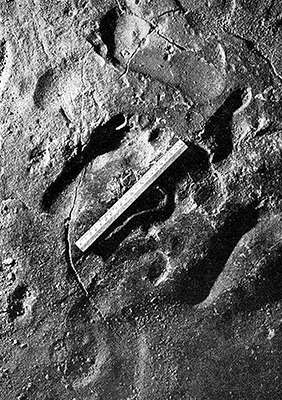
Galerie Profonde
Footprints in the floor of the cave, discovered in 1949 by a group of cavers in what is known as the Galeries Profondes, or Deep Galleries.
More than 500 foot imprints have been found.
Photo and text: Beltrán Martínez (1973)
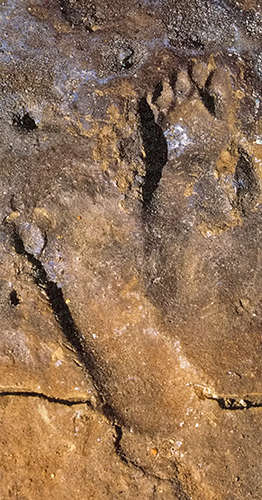
Caverne de Niaux (Ariège), galeries profondes. Empreintes de pieds
Caverne de Niaux, (Ariège), lower galleries. Footprints
Photo from: Agenda de la Préhistoire 2002 - 2003, a superb diary with excellent illustrations sent to me by Anya. My thanks as always.
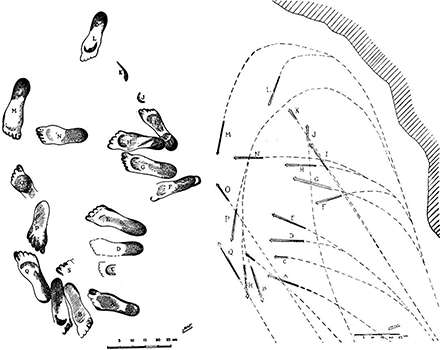
Paths taken by footprints in the floor of the cave.
The cave of Niaux is in a limestone deposit, next to a plain and at the entrance to a valley created by the Ariége river. Originally, water infiltrated the Jurassic and Cretaceous limestone layers, and when the water of these rivers disappeared there were left sometimes huge caverns of enormous height and considerable length, in contrast to the often narrow and short caves of the Dordogne.
The Magdalenian painters probably used two entrances to the cave of Niaux, one to access the Salon Noir, the other to access the Clastres Network, discovered in 1970. The lower level passage between the two sections, Les Galeries Profondes is currently flooded at several points.
Photo: Beltrán Martínez (1973)
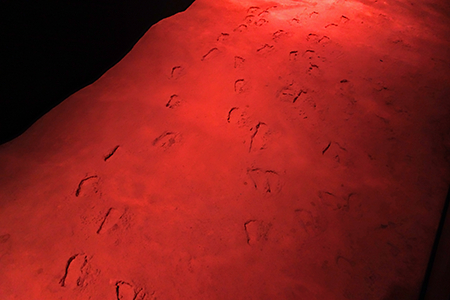
A recreation of the footprints shown above.
Photo: Ralph Frenken 2019
Source: Display, Le Parc de la Préhistoire de Tarascon-sur-Ariège
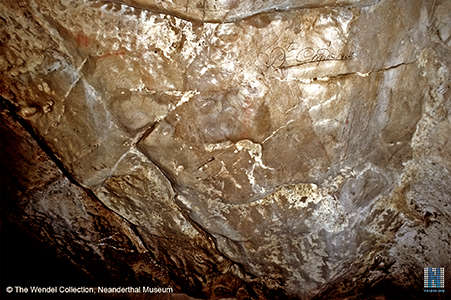
Galerie Profonde
This may be a very old graffito. Capdeville is a name which is recorded from the early 18th century in Niaux.
Photo: Heinrich Wendel (© The Wendel Collection, Neanderthal Museum)
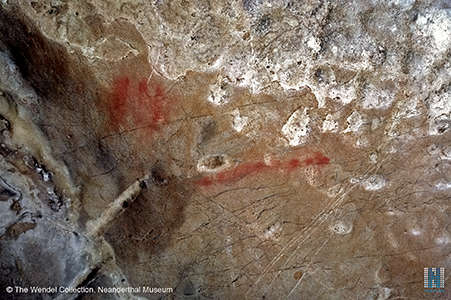
Galerie Profonde
Red symbols and dots on the ceiling, quite smudged.
Photo: Heinrich Wendel (© The Wendel Collection, Neanderthal Museum)
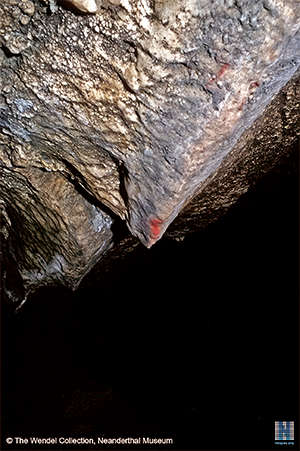
Galerie Profonde
This keel shaped ridge descending from the ceiling has been marked with red ochre, but with no obvious shape.
Photo: Heinrich Wendel (© The Wendel Collection, Neanderthal Museum)
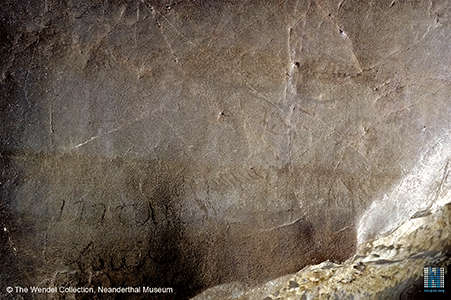
Galerie Profonde
Some simple lines in groups have been painted on this wall.
Photo: Heinrich Wendel (© The Wendel Collection, Neanderthal Museum)
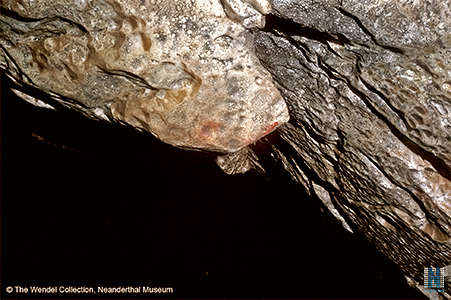
Galerie Profonde
Red ochre on the lower surface of a keel shaped ridge on the ceiling.
Photo: Heinrich Wendel (© The Wendel Collection, Neanderthal Museum)
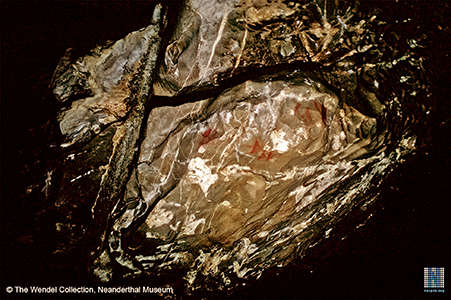
Galerie Profonde
Several simple but clear red ochre signs on a multicoloured surface.
Photo: Heinrich Wendel (© The Wendel Collection, Neanderthal Museum)
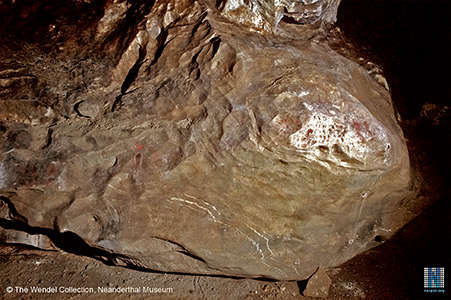
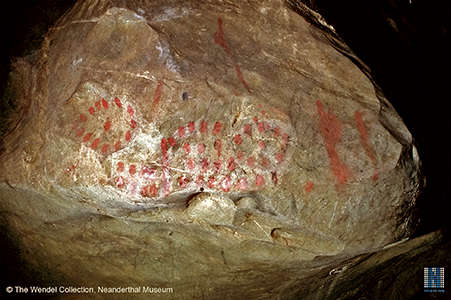
Galerie Profonde
There are two circles of red dots with a central dot on each side of two other groups of red dots here.
Shown in this image also are two claviform (club or P shaped) symbols one facing left and one facing right, as well as isolated red lines.
Photo: Heinrich Wendel (© The Wendel Collection, Neanderthal Museum)
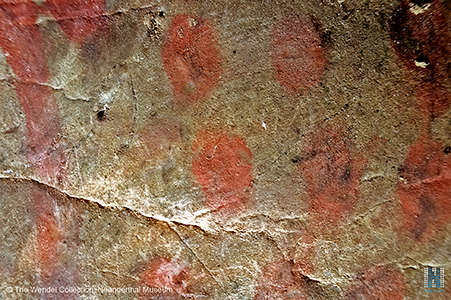
Galerie Profonde
Close up of part of the above image.
Photo: Heinrich Wendel (© The Wendel Collection, Neanderthal Museum)
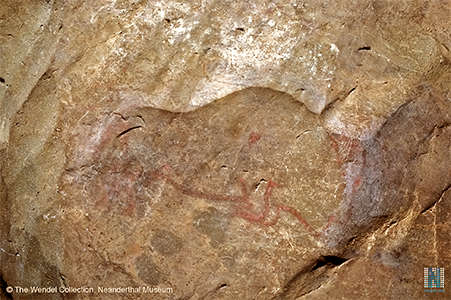
Galerie Profonde
Image of a bison making use of a natural curve in the wall which fits the dorsal line of the bison admirably. The bison appears to be leaping, and the front legs have been drawn flexed for the jump.
Photo: Heinrich Wendel (© The Wendel Collection, Neanderthal Museum)
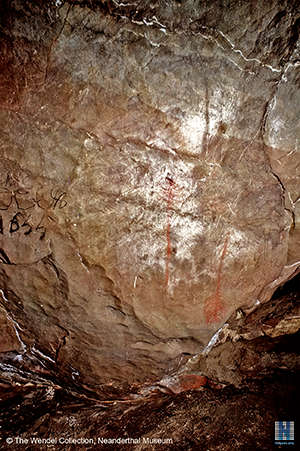
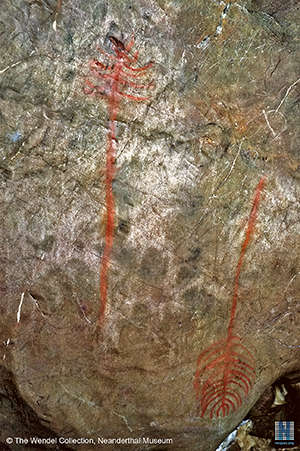
Galerie Profonde
Feather shaped images.
Photo: Heinrich Wendel (© The Wendel Collection, Neanderthal Museum)
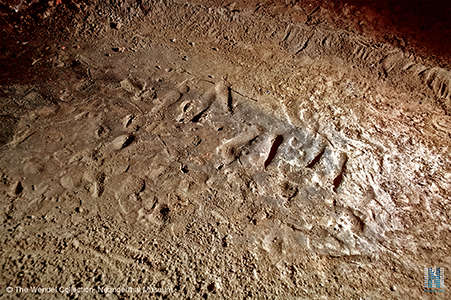
Galerie Profonde
Footprints of the artists, preserved in the mud of the floor.
Photo: Heinrich Wendel (© The Wendel Collection, Neanderthal Museum)
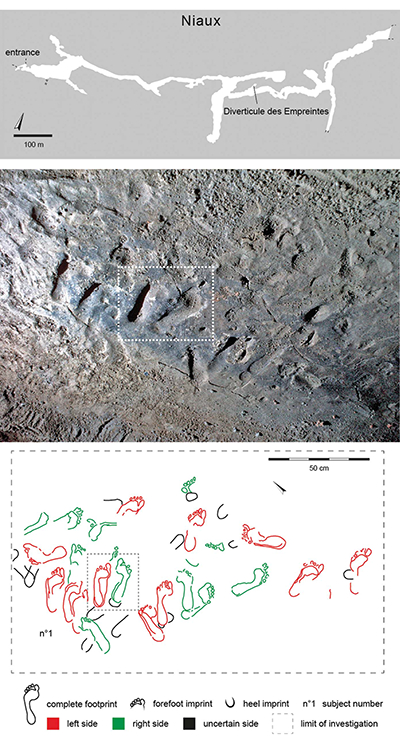
Footprints in the 'Diverticule des Empreintes'. The dotted rectangle marks a central pair of footprints for orientation. Subject: no. 1, female (12).
( photo (and drawing) rotated 180° in order to facilitate recognition of depressions and ridges - Don )
Photo: Heinrich Wendel (© The Wendel Collection, Neanderthal Museum)
Drawing after Pales (1976)
Text: Pastoors et al. (2015)
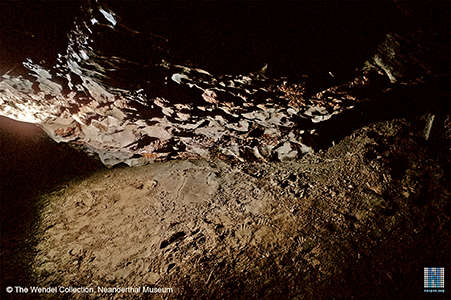
Galerie Profonde
Other marks, apparently modern, on the floor.
Photo: Heinrich Wendel (© The Wendel Collection, Neanderthal Museum)

Galerie Profonde
One of the most famous images of Niaux is this Bison, drawn on the mud of the floor. Marks from drips from the ceiling have been used as part of the design.
Photo: Heinrich Wendel (© The Wendel Collection, Neanderthal Museum)
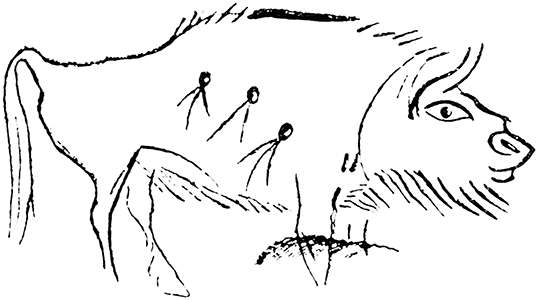
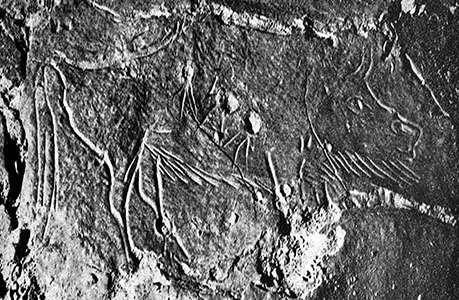
Engraved Bison, showing
drawing and a photo stretched to remove some of the distortion in the original photograph, taken at an angle.
Photo: Beltrán Martínez (1973)
 Head of the bison shown above, drawn with the fingers on the clay floor at Niaux, French Pyrenees. It lies over half a mile from the cave entrance. Dating from the Madalenian period, it measures 24 inches (60 cm) in length.
Head of the bison shown above, drawn with the fingers on the clay floor at Niaux, French Pyrenees. It lies over half a mile from the cave entrance. Dating from the Madalenian period, it measures 24 inches (60 cm) in length.
Photo: Waechter (1991)
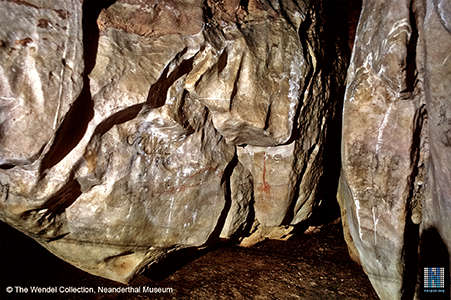
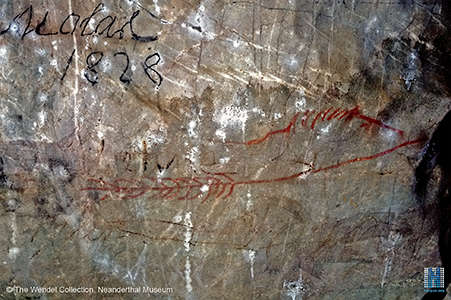
Galerie Profonde
Two more feather designs, with one combined with what may be the head of an animal.
Photo: Heinrich Wendel (© The Wendel Collection, Neanderthal Museum)
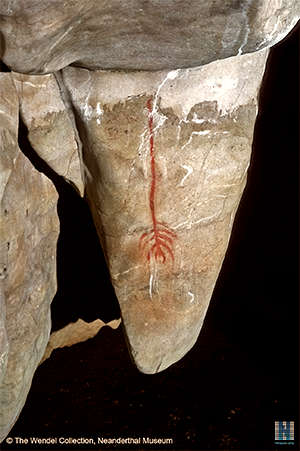
Galerie Profonde
Close up of one of the feather designs in the upper left image, drawn on a pendant from the ceiling.
Photo: Heinrich Wendel (© The Wendel Collection, Neanderthal Museum)
Galerie Cartailhac
In order to take these photos, which include the lakes at either end of the Galerie Cartailhac, Heinrich Wendel may have used scuba diving equipment to negotiate the lakes, and brought his photographic equipment with him in a waterproof container.
Map of the Galerie Cartailhac and Reseau René Clastres.
Photo: Clottes et Simonnet (1972)
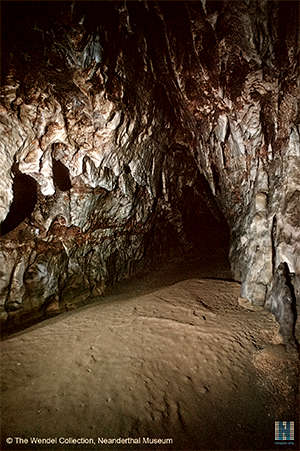
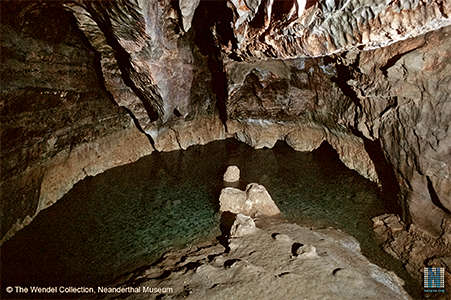
The approach to the Galerie Cartailhac from the entrance.
Photo: Heinrich Wendel (© The Wendel Collection, Neanderthal Museum)
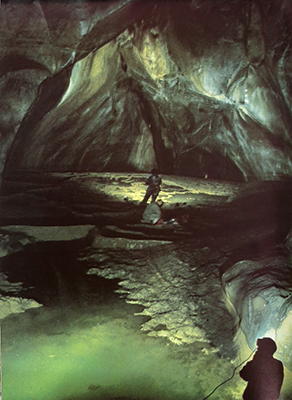
New gallery, on the way to the preserved footprints.
Photo: Jean Vertut
Source: Pfeiffer (1986)
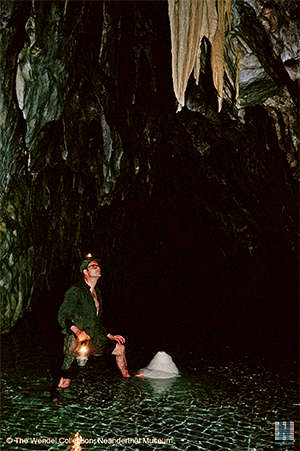
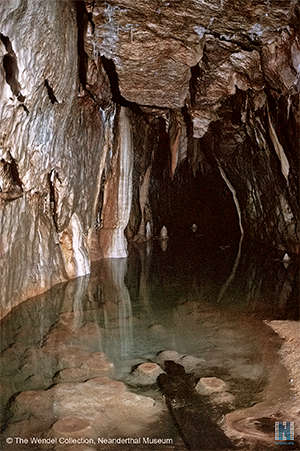
The approach to the Galerie Cartailhac from the far end.
Photo: Heinrich Wendel (© The Wendel Collection, Neanderthal Museum)
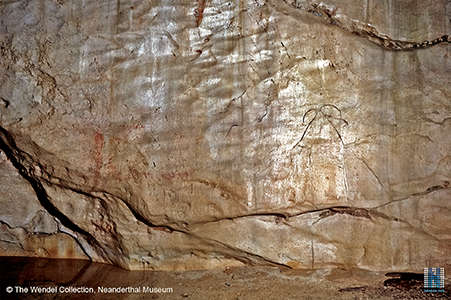
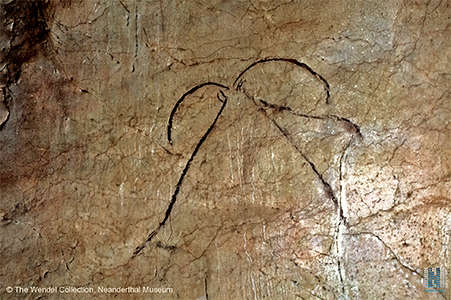
Inside Galerie Cartailhac.
An image of an ibex.
Photo: Heinrich Wendel (© The Wendel Collection, Neanderthal Museum)
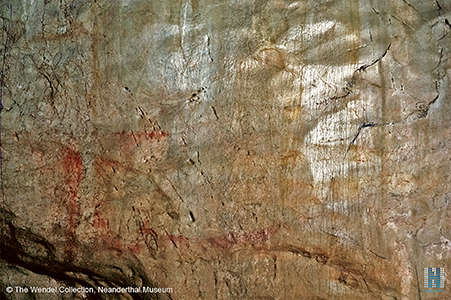

Inside Galerie Cartailhac.
This Aurochs head has been elegantly drawn using existing cracks and features of the wall to help to delineate the artwork.
Photo: Heinrich Wendel (© The Wendel Collection, Neanderthal Museum)
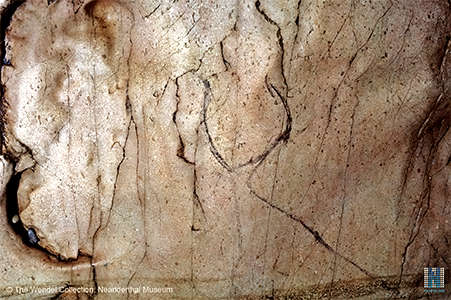
Inside Galerie Cartailhac.
This appears to be a representation of the head, shoulders and antlers of a deer.
Photo: Heinrich Wendel (© The Wendel Collection, Neanderthal Museum)
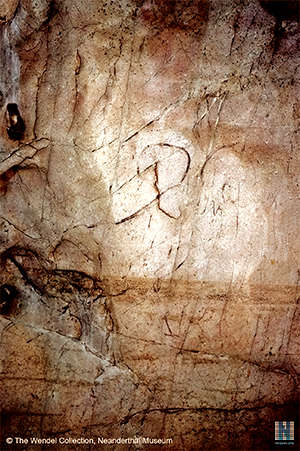
Inside Galerie Cartailhac.
This image is hard to interpret, but may be the head and horns of an ibex, a very important animal to the artists.
Photo: Heinrich Wendel (© The Wendel Collection, Neanderthal Museum)
Inside Galerie Cartailhac.
I first interpreted this as an upside down horse head, with the shape of the protrusion of the wall providing the impetus for the drawing of the representation. However the image now appears to me to be the head and horns of an ibex, facing to the left.
It has been delineated by repeated stamping in red ochre by a brush or by a thumb. A natural feature of the rock wall has been used to good effect for the outside edge of the left hand horn of the ibex.
The stamping forcefully evokes an image of the natural ridges on an ibex horn, though treating it as an upside down horse head, this stamping could well be the mane of the horse, which in Palaeolithic times were stiffly upright.
Note also the red marks on the left of the main image, visible in the photo to the left.
Photo: Heinrich Wendel (© The Wendel Collection, Neanderthal Museum)
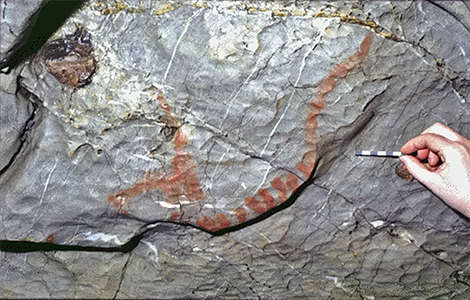
This is a useful image, since the scale is given in centimetres.
In addition, this site gives the origin of the artwork as the Galerie des Marbres rather than Galerie Cartailhac, and plumps for the upside down horse head interpretation.
Photo: http://www.lrmh.culture.fr/
Réseau René Clastres
This is at the far end of the Galerie Cartailhac, and was accessed by the original artists from the cave known as La Petite Caougno, a little further down the mountain, with a different entrance to the main one of Niaux.
Map of the Galerie Cartailhac and Reseau René Clastres.
Photo: Clottes et Simonnet (1972)
The Réseau René Clastres was discovered by divers in 1970, but getting cameras, equipment, and researchers to the newly discovered area without the requisite scuba diving qualifications, fitness and experience was impossible without draining the intervening siphons and lakes.
Jean Clottes, in Clottes et Simonnet (1972), writes, in part:
The continuation of the various studies undertaken in the network thus required the natural disappearance of Lake 4 (seasonal) and the pumping of Lake 3 (permanent). When these conditions were established, communication between the huge formerly known galleries of Niaux and the René Clastres network would not fail to profoundly disrupt the climate of both systems.
Thus, during the summer of 1971, we built a partition wall with a watertight door immediately upstream of Lac Vert, which restored the conditions existing prior to the works mentioned by Count Bégouën, and made it possible to make the new network once again accessible without risking climate changes with unforeseeable consequences. After divers crossed Lake 3, and verified that Lake 4 had disappeared, we began pumping Lakes 1, 2 and 3. This operation, long and very painful (the lakes are located between 1000 and 1200 metres from the entrance), allowed us to appreciate the work done by the speleologists who are at the origin of the discovery. ....... The drying up of the lakes (completed by a final pumping at the end of January 1972) allowed us to complete the identification and recording of footprints, the survey and photographic coverage of the great dune of the Hall of Paintings, the exploration and partial survey of some high galleries, and especially the installation of cables and apparatus necessary for the climatological study of the Hall of Paintings.
The new network is indeed an ideal environment to study the conditions of conservation of prehistoric paintings out of the presence of man, since it has remained in isolation for millennia and these conditions will be naturally restored by the rise of lakes.
Jean Clottes continues:
Over its first two hundred metres, the new network retains the north-south direction of the Galerie Cartailhac. It then turns west and runs parallel to the main Niaux gallery, returning to the Vicdessos valley. The main lines represent about one kilometer of galleries. The galleries are relatively large, while being of average width and height less than the large gallery of Niaux. The narrow passages are due to stalagmite outgrowths or mond-milch deposits. The topography itself does not present any particular obstacle, the only jump at the skylight being easily crossed.( This whimsically named skylight (lucarne on the map), just after the ephemeral Lake 4, is obviously a small crevasse in the floor to be jumped rather than an opening in the roof - if there had been such an opening, it would have been made much of in this report, especially for use as an alternative future entry to the Réseau. In addition, bats would have long since discovered it, and there was no evidence in the Réseau of recent incursions by bats, as there has been at the nearby La Petite Caougno - Don )
Map of the location of the remains in the central part of the network. Charcoal is shown by black triangles, and human and weasel footprints are shown by appropriate symbols.
1: Imprints of a weasel footprint overlaying a child's footprint.
2: human footprints.
3: human and weasel footprints.
4: human footprints and charcoal from a later time.
5: human footprints.
Photo: Clottes et Simonnet (1972)
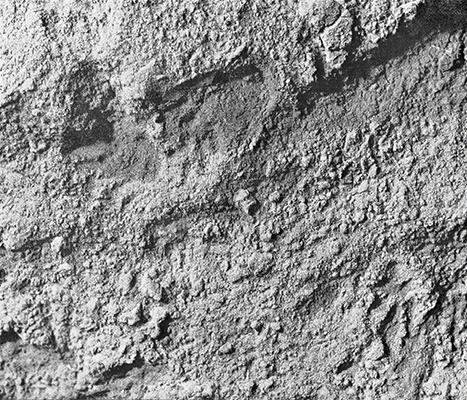
Imprints of a weasel footprint overlaying a child's footprint (18 cm, n° 1).
( rotated 180 ° to have the light coming from the top left, to aid the interpretation of hollows and ridges - Don )
Photo and text: Clottes et Simonnet (1972)
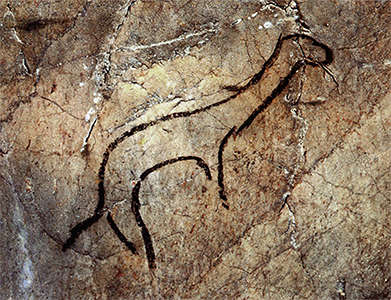
Outline of a weasel in the Réseau René Clastres, the Clastres Network. Representations of weasels are very rare in rock art.
Photo: http://elationcreations.wordpress.com/2011/09/14/wonderful-weasel-wednesday-2/
Jean Clottes continues:
...... Many deposits and veneers of pebbles, gravel and sand remain on the ground and on the walls (more than 10 metres high in the Hall of Paintings); just like the suspended floors, they are the remains of fills having clogged most of the network. If it is assumed that these fillings are prior to Würm, their emptying occupies a more uncertain chronological place. The present soil, consisting essentially of these sediments, covered or not depending on the location of a stalagmitic deposit, was to have its current profile at the beginning of the Upper Paleolithic, or, at most, the Würm 4, as local stratigraphies seem to indicate. It has therefore allowed the existence and preservation of footprints.
Network issues may have been multiple: the new network is located relatively close to one of the slopes of the Arbiech valley and is parallel to it; on the other hand, the weasel entered, as we shall see, the middle part (Salle des Peintures, Hall of Paintings). This part has also been used once by bats, with blackish deposits on the walls and quite a few skeletons on the ground, sometimes calcified. It was the same for the bottom of the network (same findings with, in addition, heaps of guano).
However, we have never noticed live bats in the new galleries, while they still live in the Petite Caougno de Niaux, located near the end of the René Clastres network. Although these animals do not require large galleries, the fact remains that passages directly to the outside or to other open cavities are currently collapsed or clogged; it may be one of those that was used by prehistoric people. The problem of humans entering the network is thus posed; we will examine it in more detail after having studied the distribution of the remains, and taking into account the natural obstacles and the topography of the places.
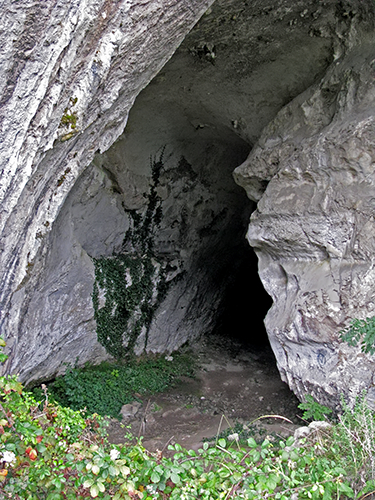
This is the entrance to the Petite Caougno de Niaux, a 450 metre long cave which is no longer connected to the Réseau René Clastres, as it was originally.
Photo: Don Hitchcock 2008
Paintings of a weasel and a horse.
Photo (left): Ralph Frenken 2019
Source: Facsimile, Le Parc de la Préhistoire de Tarascon-sur-Ariège
Photo (right): Clottes et Simonnet (1972)
The weasel.
Photo (left): Ralph Frenken 2019
Source: Facsimile, Le Parc de la Préhistoire de Tarascon-sur-Ariège
Photo (right): Clottes et Simonnet (1972)
The horse.
Photo (left): Ralph Frenken 2019
Source: Facsimile, Le Parc de la Préhistoire de Tarascon-sur-Ariège
Photo (right): Clottes et Simonnet (1972)

Three bison in the Réseau René Clastres.
Photo and text: Clottes et Simonnet (1972)
Bison number three (left) and Bison number one (right) in the Réseau René Clastres.
Photo and text: Clottes et Simonnet (1972)
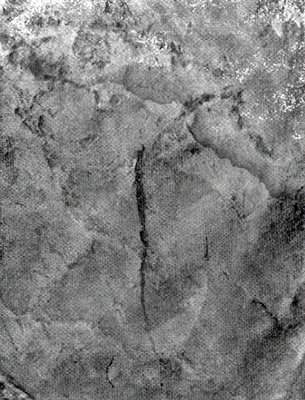
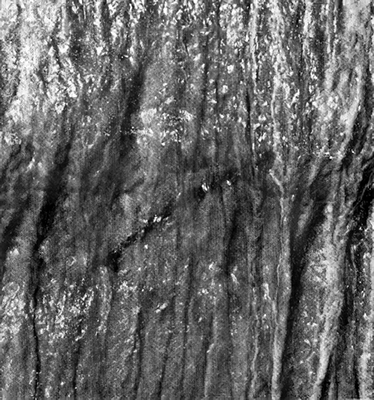
Lines drawn in black on the walls.
Line 1 (left): after Lake 4.
Line 2 (right): near dune n° 14.
Photo and text: Clottes et Simonnet (1972)
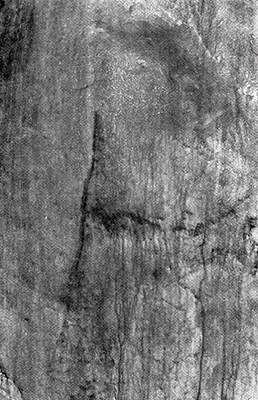
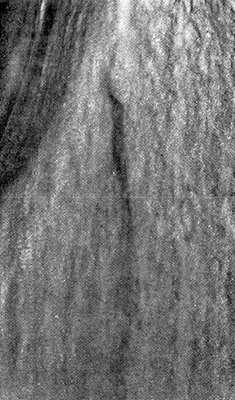
Lines drawn in black on the walls.
Lines 3 and 4 were drawn on each side of the narrow passage overlooking the Hall of Paintings.
Photo and text: Clottes et Simonnet (1972)
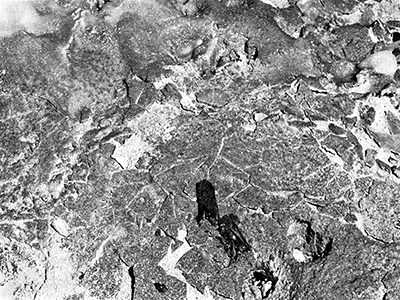
Prehistoric charcoal on the surface of a flowstone crust covering human footprints (No. 4 on the map).
Note a human footprint on the top left (at an earlier time) and the network of fine cracks of the flowstone crust (at a later time).
Photo and text: Clottes et Simonnet (1972)
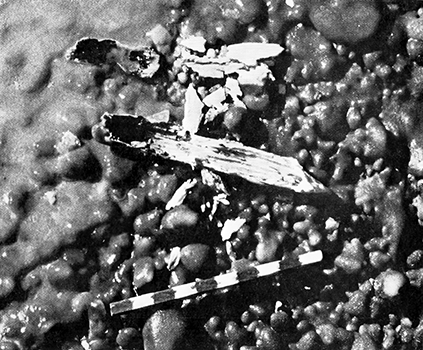
Prehistoric torch partly consumed.
Photo and text: Clottes et Simonnet (1972)
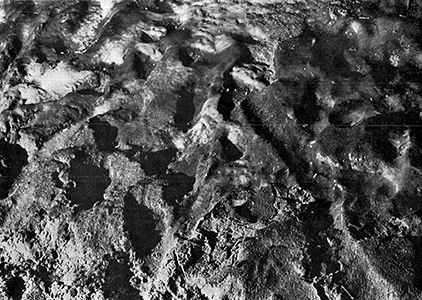
Series of human footprints (at No. 4 on the map), covered with calcite.
Photo and text: Clottes et Simonnet (1972)
La Petite Caougno
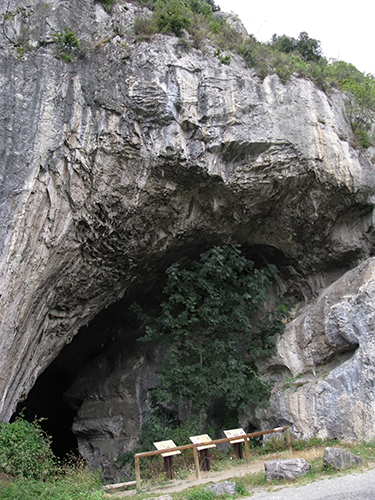
On the way back down the steep road from Niaux, I stopped to have a look at the entrance to La Petite Caougno. It was the original entry to the Réseau René Clastres for the artists of Niaux.
Photo: Don Hitchcock 2008
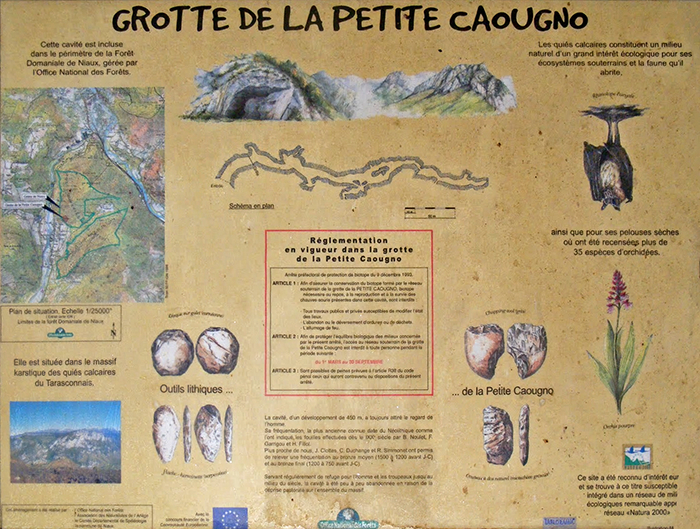
Sign at the entrance to La Petite Caougno.
Photo: http://ges-cmterrassa.blogspot.com/2009/10/volvemos-al-ariege.html

The cave is home to many bats. Access is prohibited from May 1 to September 30 in order to protect them.
Photo: Don Hitchcock 2008
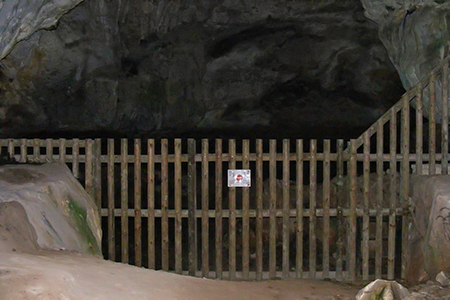
The 250 metre long cave is blocked off a little way inside this entrance by a fence.
Photo: http://ges-cmterrassa.blogspot.com/2009/10/volvemos-al-ariege.html

Niaux - Description and History

Niaux aerial photo, map and plan
References
- Beltrán Martínez, A., 1973: La cueva de Niaux (Monografias arqueologicas), Departamento de Prehistoria y Arqueologia, Fac. Letras
- Breuil, H., Cartailhac É., 1907: Une seconde campagne aux cavernes ornées de Niaux (Ariège) et de Gargas (Hautes-Pyrénées). Comptes-rendus des séances de l'année.. - Académie des inscriptions et belles-lettres, 51e année, N.4, 1907. pp. 213-222.
- Clottes, J., Simonnet R., 1972: Le réseau René Clastres de la Caverne de Niaux (Ariège), in: Bulletin de la Société préhistorique française, Études et travaux, tome 69, n°1, 1972. pp. 293-323; doi : https://doi.org/10.3406/bspf.1972.8166 https://www.persee.fr/doc/bspf_0249-7638_1972_hos_69_1_8166
- Leroi-Gourhan A., 1984: L'Art des cavernes : Atlas des grottes ornées paléolithiques françaises, Relié – 1 décembre 1984
- Leroi-Gourhan A., 1984: L'Art des cavernes : Atlas des grottes ornées paléolithiques françaises, Relié – 1 décembre 1984
- Pailhaugue, N., 1998: Faune et saisons d'occupation de la salle Monique au Magdalénien Pyrénéen, Grotte de la Vache (Alliat, Ariège, France), Quaternaire, Volume 9, Numéro 4, 1998. pp. 385-400
- Pales, L., 1976: Les empreintes de pieds humains dans les cavernes: Les empreintes du réseau nord de la caverne de Niaux (Ariège), Paris: Masson.
- Pastoors A. et al. , 2015: Tracking in Caves: Experience based reading of Pleistocene human footprints in French caves, Cambridge Archaeological Journal, doi:10.1017/S0959774315000050
- Pfeiffer, J., 1986: The Creative Explosion: An Inquiry into the Origins of Art and Religion, Horizon Book Promotions; 1st edition (November 1986)
- Rappenglück, M. , 2002: The Claviform P-Sign a Time Unit? – Interpreting a Palaeolithic Symbol, TIstorija i kultura vostoka Asii, Tom I, pp. 224-229. Novosbirisk: Institut archeologii i etnografii SO RAN, 2002.
- Sieveking, H., 1979: The Cave Artists, London: Thames & Hudson, 1979.
- Valladas, J. et al, 1992: Direct radiocarbon dates for prehistoric paintings at the Altamira, El Castillo and Niaux cavesNature, 357, 68 - 70 (07 May 1992); doi:10.1038/357068a0
- Waechter, J. , 1991: Man Before History (The Making of the Past), Peter Bedrick Books (January 1991)
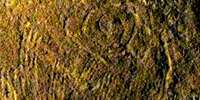 La Grotte de la Vache is important for the complete camp of Magdalenian hunters found, and may be seen almost as it was 12 000 to 15 000 years ago. Weapons, tools, typical game and artworks have been recovered from this small but important site. It was the living quarters for the artists at Niaux Cave, just across the Vicdessos Valley.
La Grotte de la Vache is important for the complete camp of Magdalenian hunters found, and may be seen almost as it was 12 000 to 15 000 years ago. Weapons, tools, typical game and artworks have been recovered from this small but important site. It was the living quarters for the artists at Niaux Cave, just across the Vicdessos Valley. 